|
Birds
28/09/17
A rare moment along the Emm , 6 Yellowhammer were seen sitting on top of the hedges in Area 8 by Paul O'Neill.
26/09/17
A line of 5 Jay flew across Area 8, this afternoon calling.A Barn Owl was seen sitting at entrance of box in Area 10 by John McGowan.
24/09/17
At my garden feeders Greenfinch have reappeared.2 were seen this morning.
19/09/17
A Mandarin duck was seen flying W over the Area 10 car park field by Marek Walford.
19/09/17
Area 10 and in the Pines to the back of the Dinton Activity Centre another Spotted Flycatcher was seen by Marek Walford and Steven Day.
17/09/17
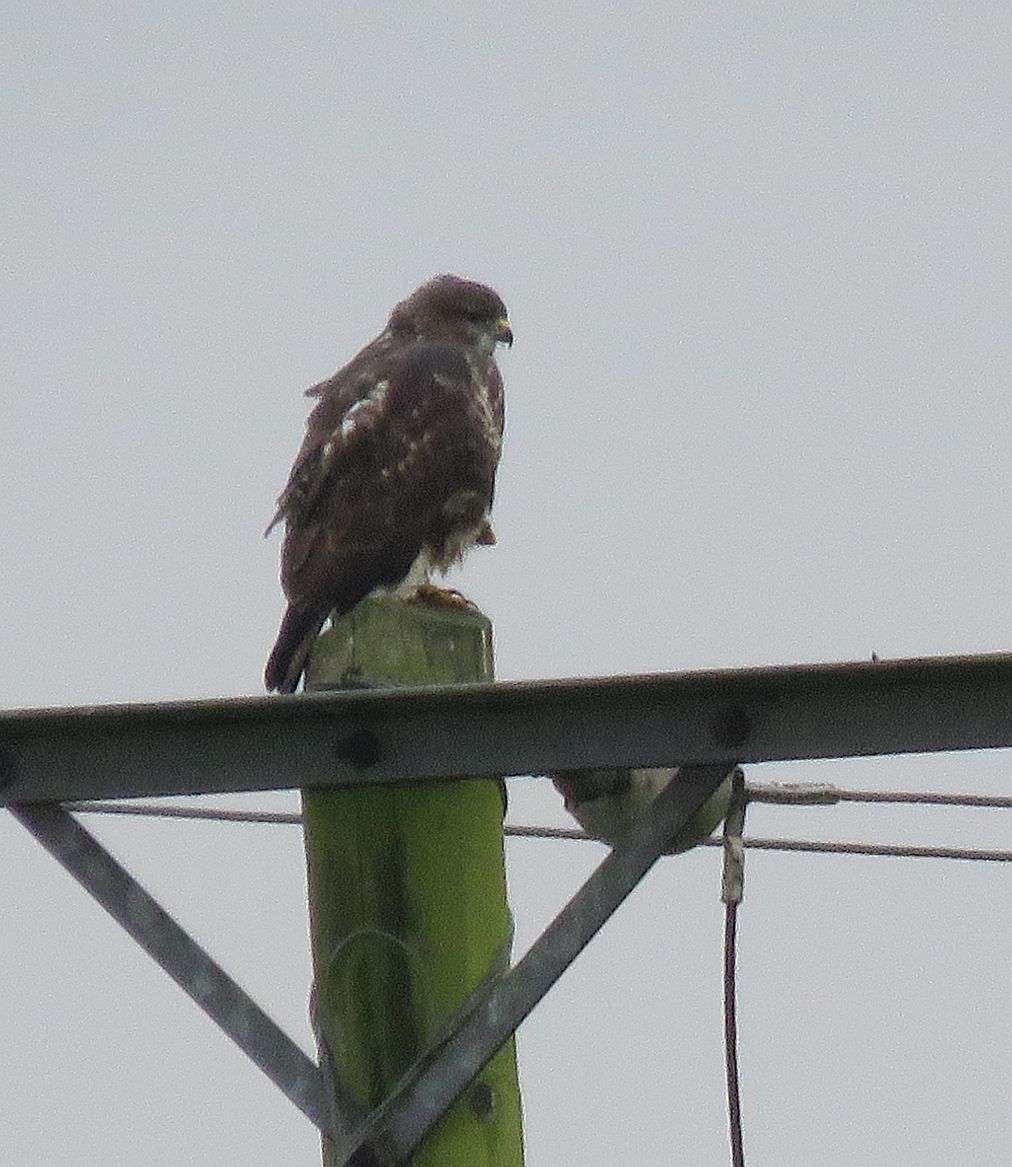 On a telegraph pole at a very overcast Area 10 a Buzzard was perched,possibly waiting for the decent weather. Chiffchaff and Blackcap were in the hedges. In Area 5 a Grey Heronflew over calling at 07:00.
On a telegraph pole at a very overcast Area 10 a Buzzard was perched,possibly waiting for the decent weather. Chiffchaff and Blackcap were in the hedges. In Area 5 a Grey Heronflew over calling at 07:00.
16/09/17
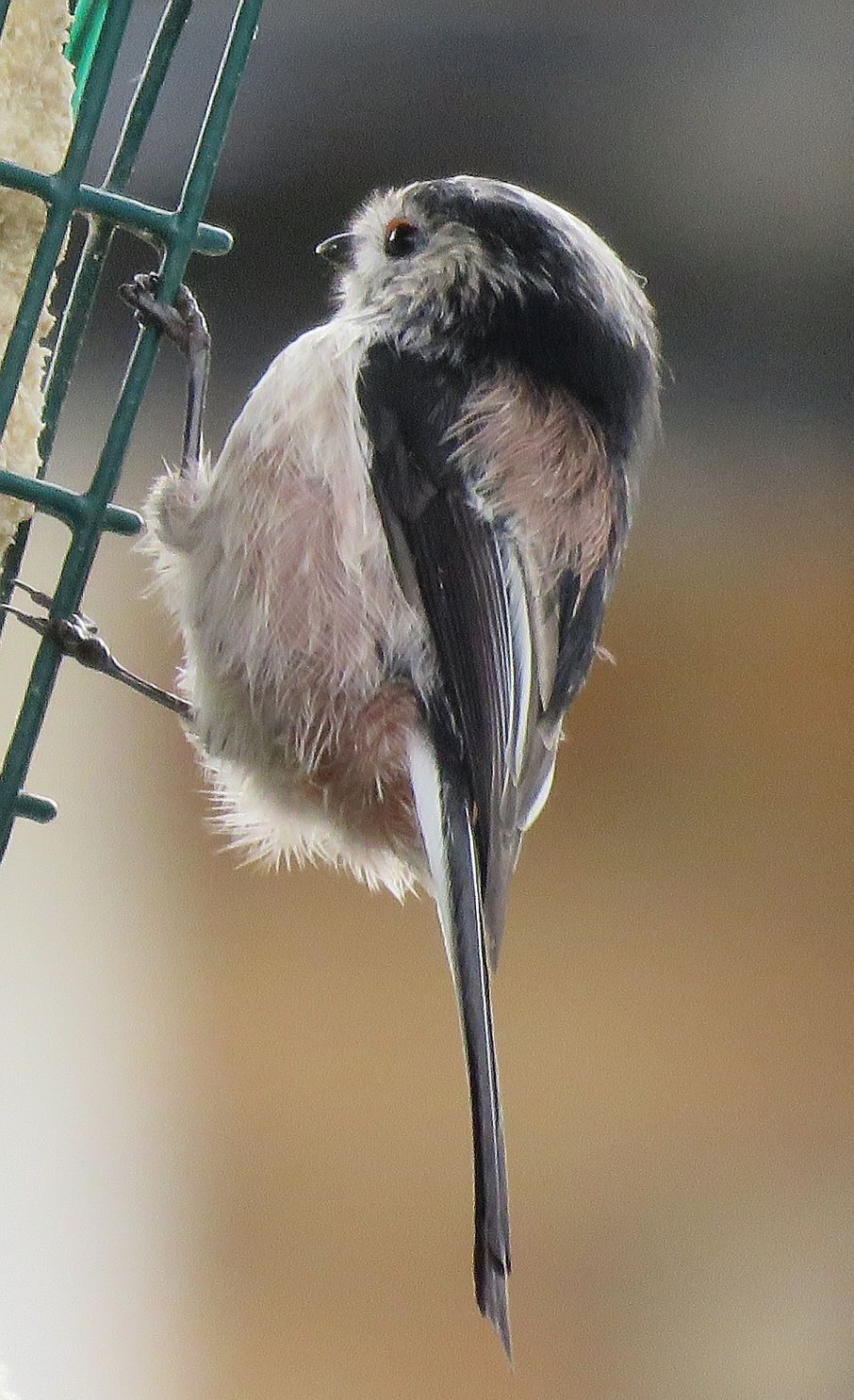 My Area 5 garden feeders were very busy today with the usual suspects for the time of the year. 2 Long tailed Tit , were on the fat feeders. At least 7 Goldfinch and a solitary Nuthatch were on the Sunflower seeds.
My Area 5 garden feeders were very busy today with the usual suspects for the time of the year. 2 Long tailed Tit , were on the fat feeders. At least 7 Goldfinch and a solitary Nuthatch were on the Sunflower seeds.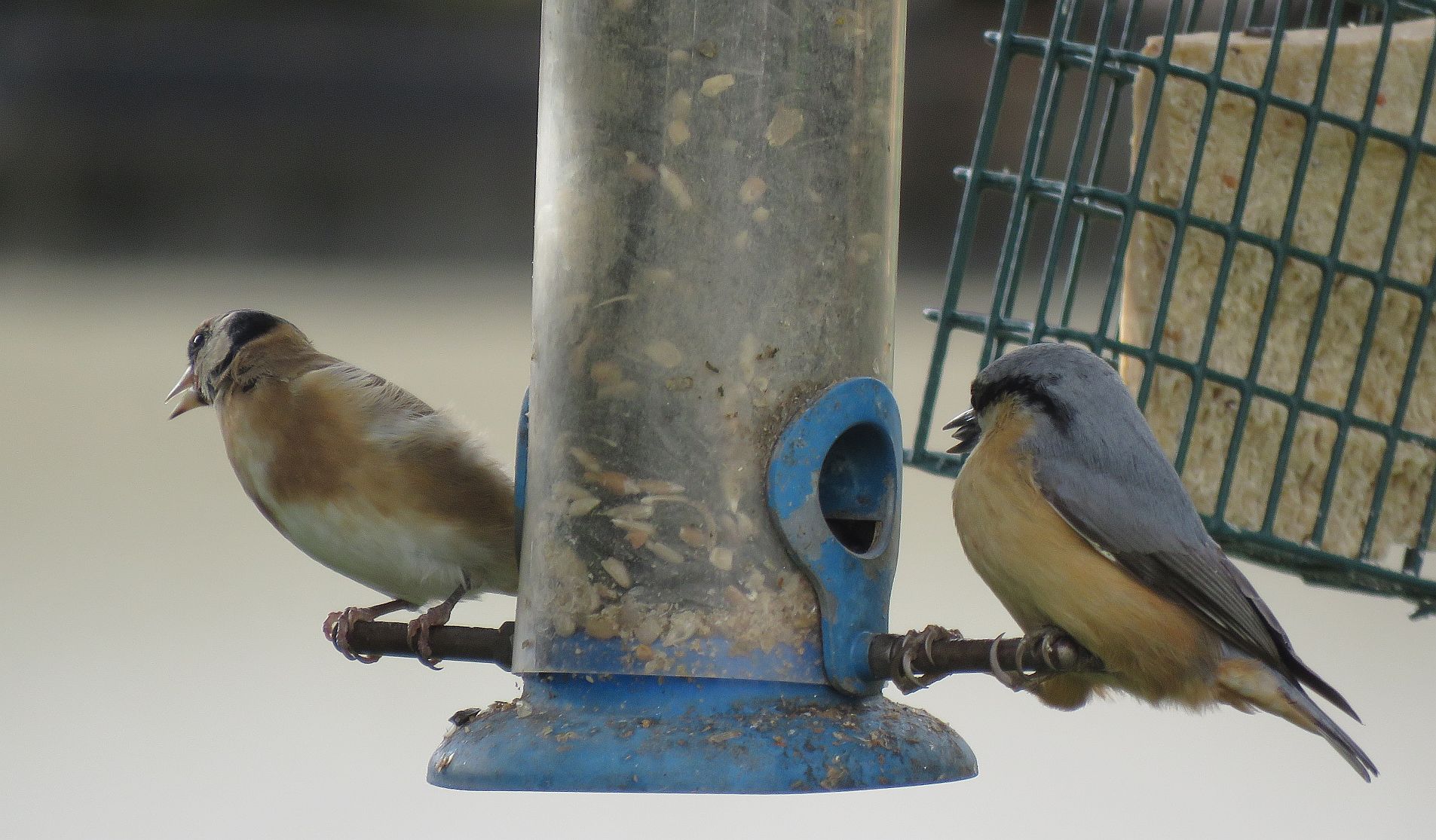 . Wood Pigeon ,Collared Dove ,Dunnock and numerous Blue Tit were also seen. . Wood Pigeon ,Collared Dove ,Dunnock and numerous Blue Tit were also seen. 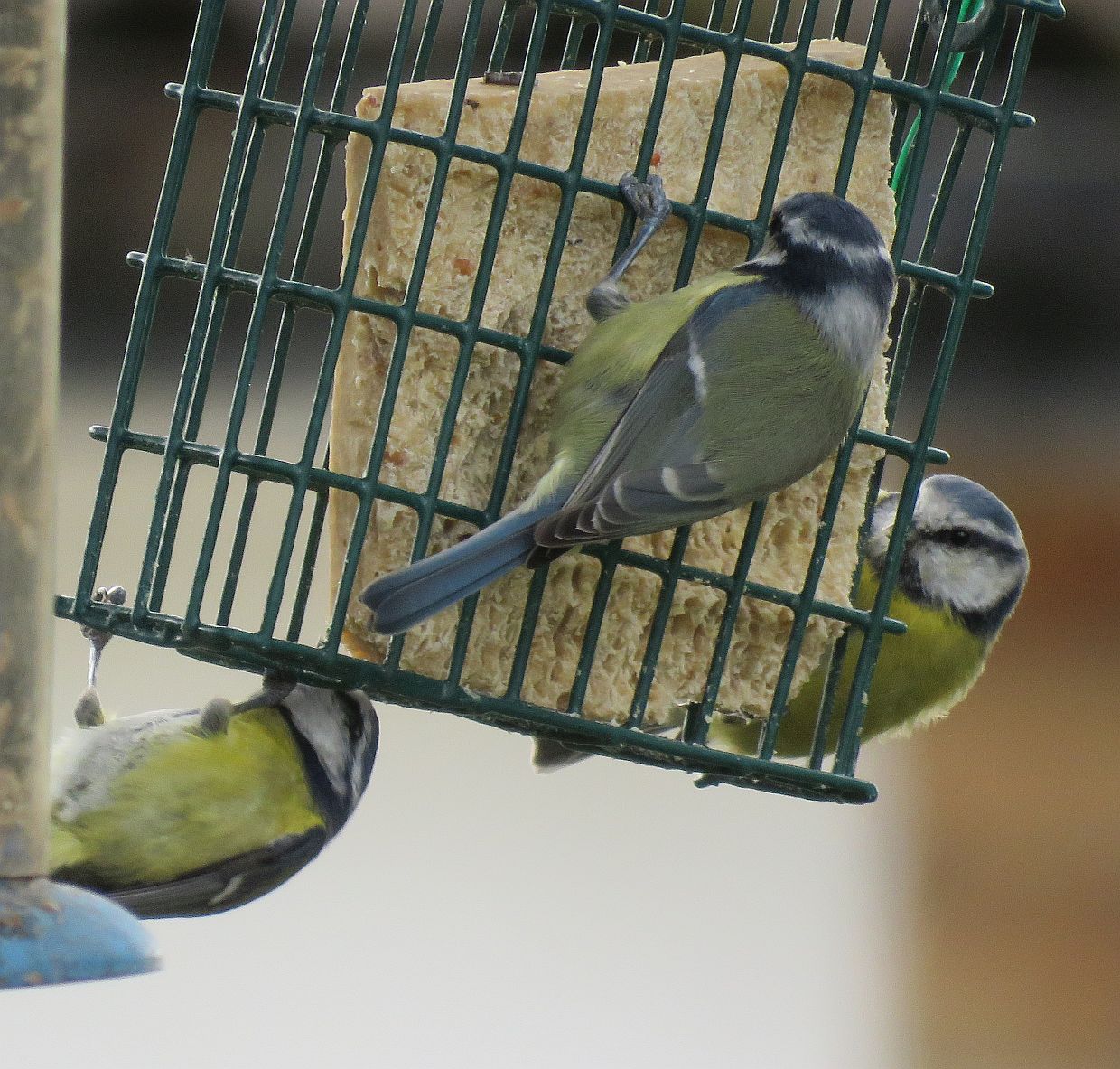 . A Red Kite flew over and a Magpie flitted in and out .Paul O'Neill was a bit more mobile in Area 8 and Old Forest Road Meadows and saw 6 . A Red Kite flew over and a Magpie flitted in and out .Paul O'Neill was a bit more mobile in Area 8 and Old Forest Road Meadows and saw 6 ,Buzzard and 2Red Kite in the same thermal over the M4. A small flock of 5 Swallow and 2 House Martin were heading South. Also seen were 2 Lesser Whitethroat ,6 Chiffchaff ,3 Ring necked Parakeet and a Green Woodpecker .
14/09/17
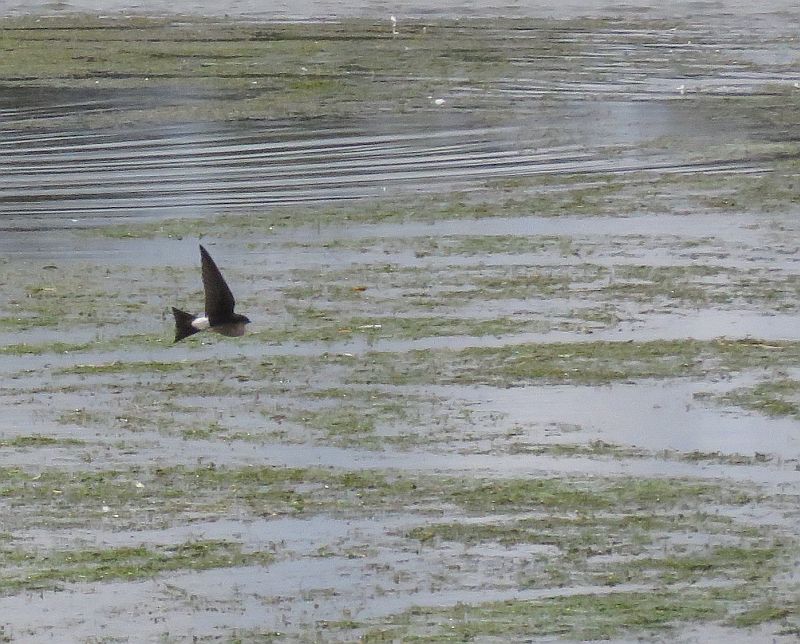 The return South is definitely under way. Again over Black Swan Lake and the Emm by the Dinton Activity Centre (DAC)large numbers of Sand Martin and House Martin were feeding. 2 Spotted Flycatcher were seen by Marek Walford and Fraser Cottington by the DAC.
The return South is definitely under way. Again over Black Swan Lake and the Emm by the Dinton Activity Centre (DAC)large numbers of Sand Martin and House Martin were feeding. 2 Spotted Flycatcher were seen by Marek Walford and Fraser Cottington by the DAC.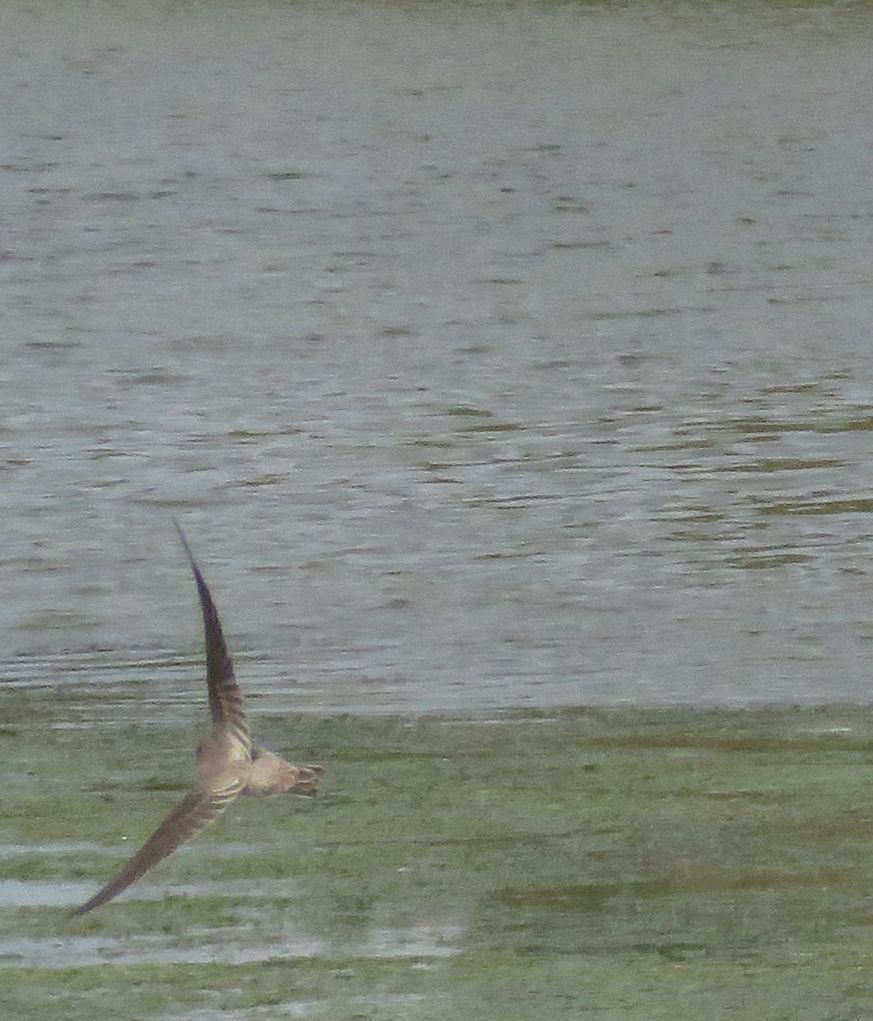 At lunchtime 6 Buzzard were feeding on the floor in a recently ploughed and seeded field in Area 1. At lunchtime 6 Buzzard were feeding on the floor in a recently ploughed and seeded field in Area 1. 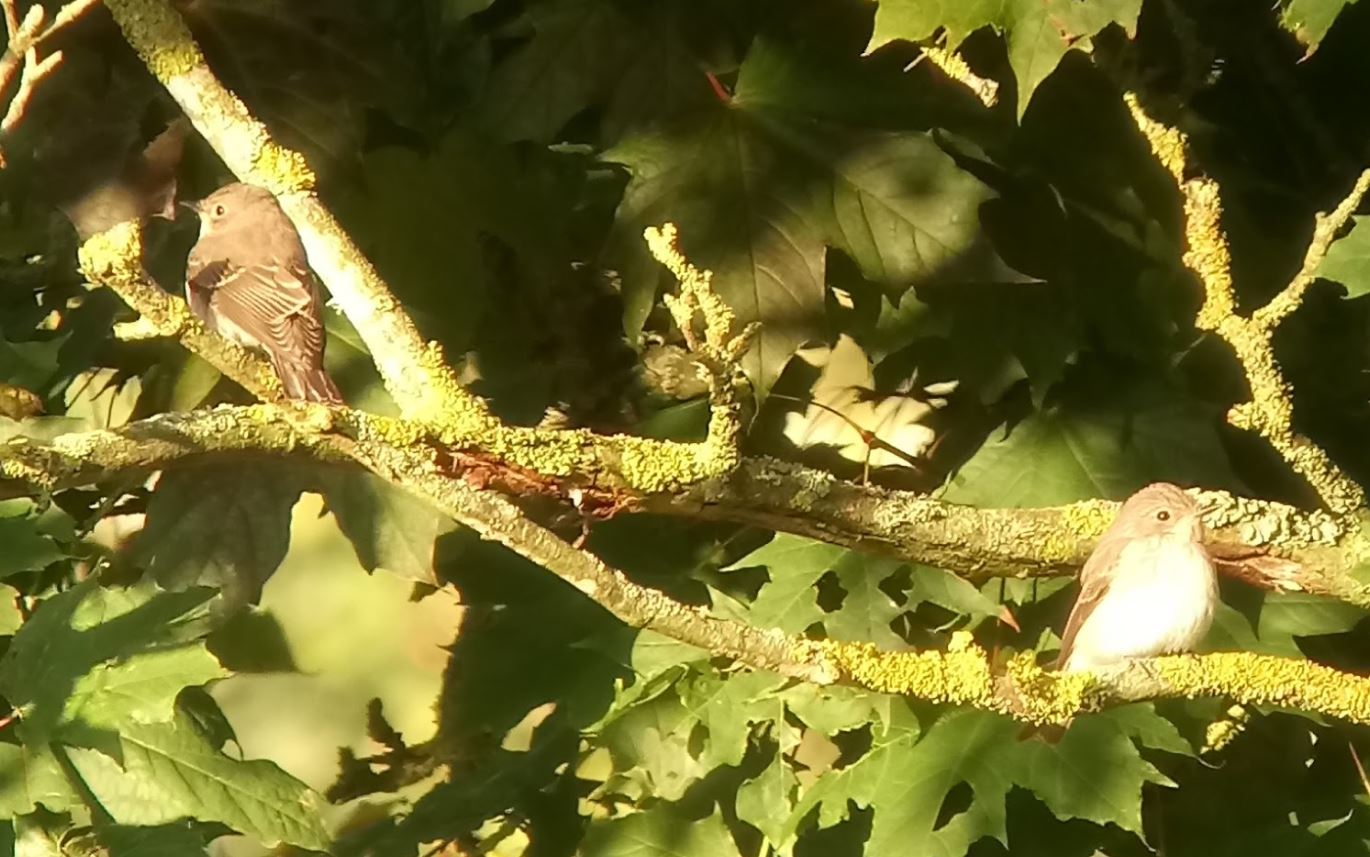 . Photo courtesy of Fraser Cottington. . Photo courtesy of Fraser Cottington.
13/09/17
Fraser Cottington and Richard Marsh were at the bottom of the Area 10 Car Park field watching a Spotted Flycatcher in the large Hawthorn Bush ,when an Osprey appeared over the landfill heading South before disappearing over Black Swan Lake. In Area 8, Paul O'Neill saw 2 Buzzard , 1 Adult and 1 juvenile1 and a Sparrowhawk . In the stubble field were 150-200 Wood Pigeon and 10 Stock Dove . A solitary Sand Martin drifted over and 4 Chiffchaff were in the bushes.
10/09/17
 I took an early morning walk around the Area 10 Car Park field , the Dinton Activity Centre and the old Golf Course. Feeding over the Emm and Black Swan Lake, were approx 500 House Martin , 4 Swallow and a late Swift .With that many Hirundines in the air it was no suprise to see a Hobby on patrol.Chiffchaff were calling and feeding on the sunlight hedges. It would appear that we are now in Meadow Pipit season as another 5 flew over heading S calling.
I took an early morning walk around the Area 10 Car Park field , the Dinton Activity Centre and the old Golf Course. Feeding over the Emm and Black Swan Lake, were approx 500 House Martin , 4 Swallow and a late Swift .With that many Hirundines in the air it was no suprise to see a Hobby on patrol.Chiffchaff were calling and feeding on the sunlight hedges. It would appear that we are now in Meadow Pipit season as another 5 flew over heading S calling.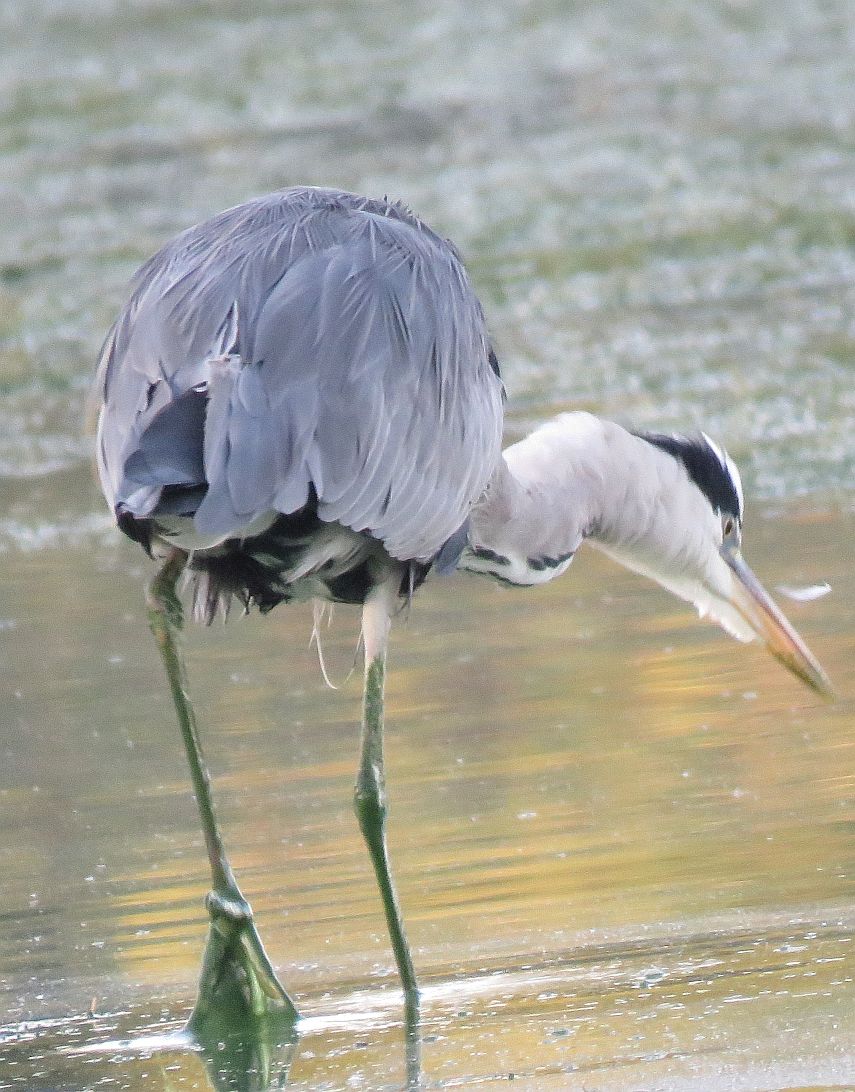 On the beach by the Dinton Activity Centre were Pied & Grey Wagtail and a Grey Heron wading through the algae . On the beach by the Dinton Activity Centre were Pied & Grey Wagtail and a Grey Heron wading through the algae .
09/09/17
Paul Bright Thomas was in Area 4 and saw a Kingfisher moving along the Emm Brook, also a total of 8 Meadow Pipit flew over heading S in two waves.Fraser Cottington was out and about in the Area 10 Car Park field in the hedges were Sedge Warbler , Lesser Whitethroat , 8-10 Blackcap and several Chiffchaff . Along the Emm between the Dinton Activity Centre and the old Golf Course he then saw a Spotted Flycatcher which was sat on a tree and 23 Mistle Thrush flying over.
07/09/17
Before I had left for work this morning two flocks of calling Canada Goose these totaled approx 20-25 birds flew over my Area 5 garden at 06:45,heading for Windmill Pond. Later in the day 20 Goldfinch were emptying my garden feeders.
04/09/17
My incredibly short stop at Dinton Pastures at lunchtime, just happened to coincide with a flock of 50+ hirundines ( a few Swallow , but mostly House Martin )heading South over the car park field, more were also seen feeding over the Emm Brook and Black Swan Lake, possibly 100+ in total.
03/09/17
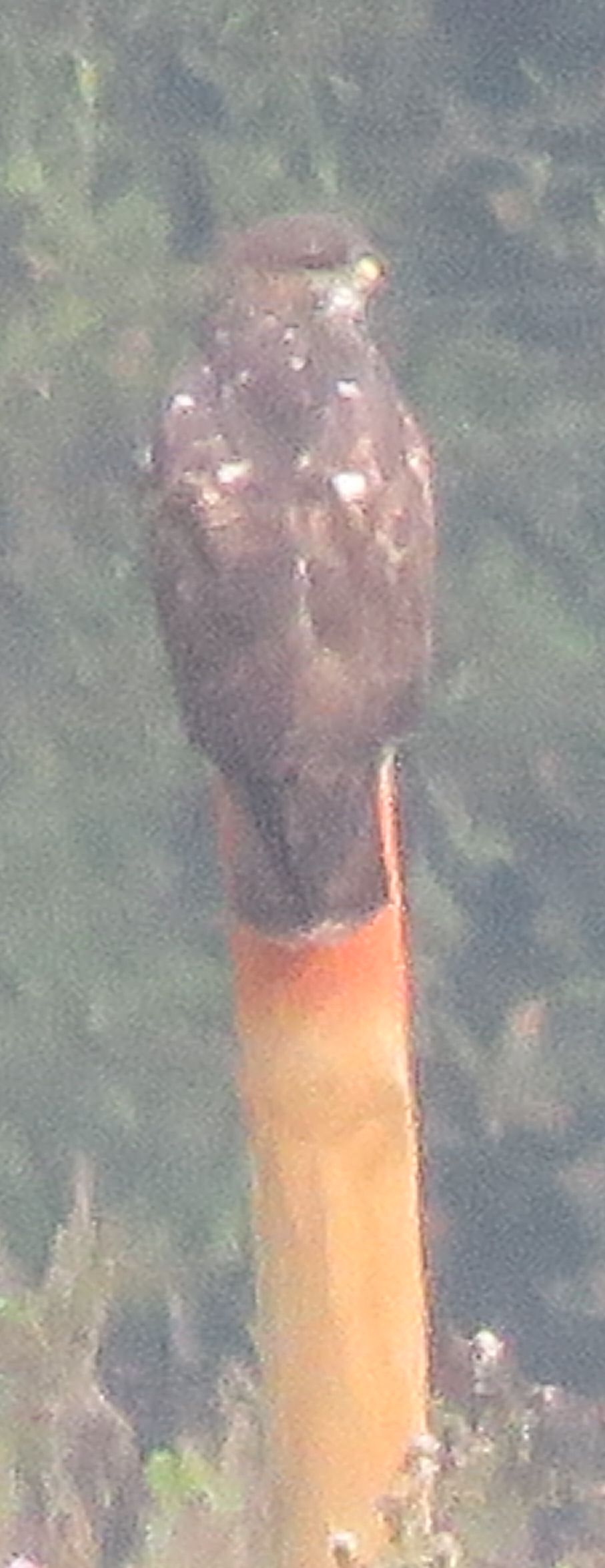 At the back of the landfill at the bottom of the car park field in Area 10 this morning , was a very distant Buzzard resting on a post allowing a very fuzzy shot. Also apart from some of yesterdays birds were 2 Song Thrush
At the back of the landfill at the bottom of the car park field in Area 10 this morning , was a very distant Buzzard resting on a post allowing a very fuzzy shot. Also apart from some of yesterdays birds were 2 Song Thrush 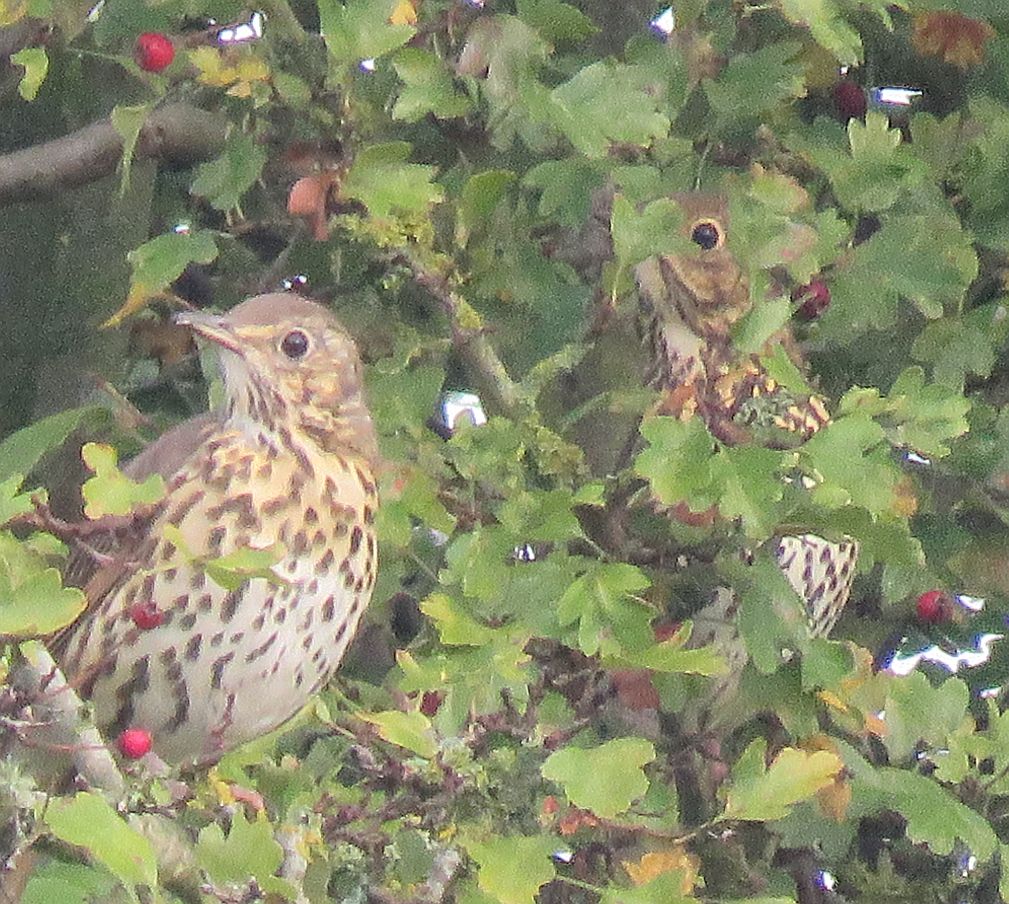 in the Hawthorn bush at the bottom of the Car Park field. in the Hawthorn bush at the bottom of the Car Park field.
02/09/17
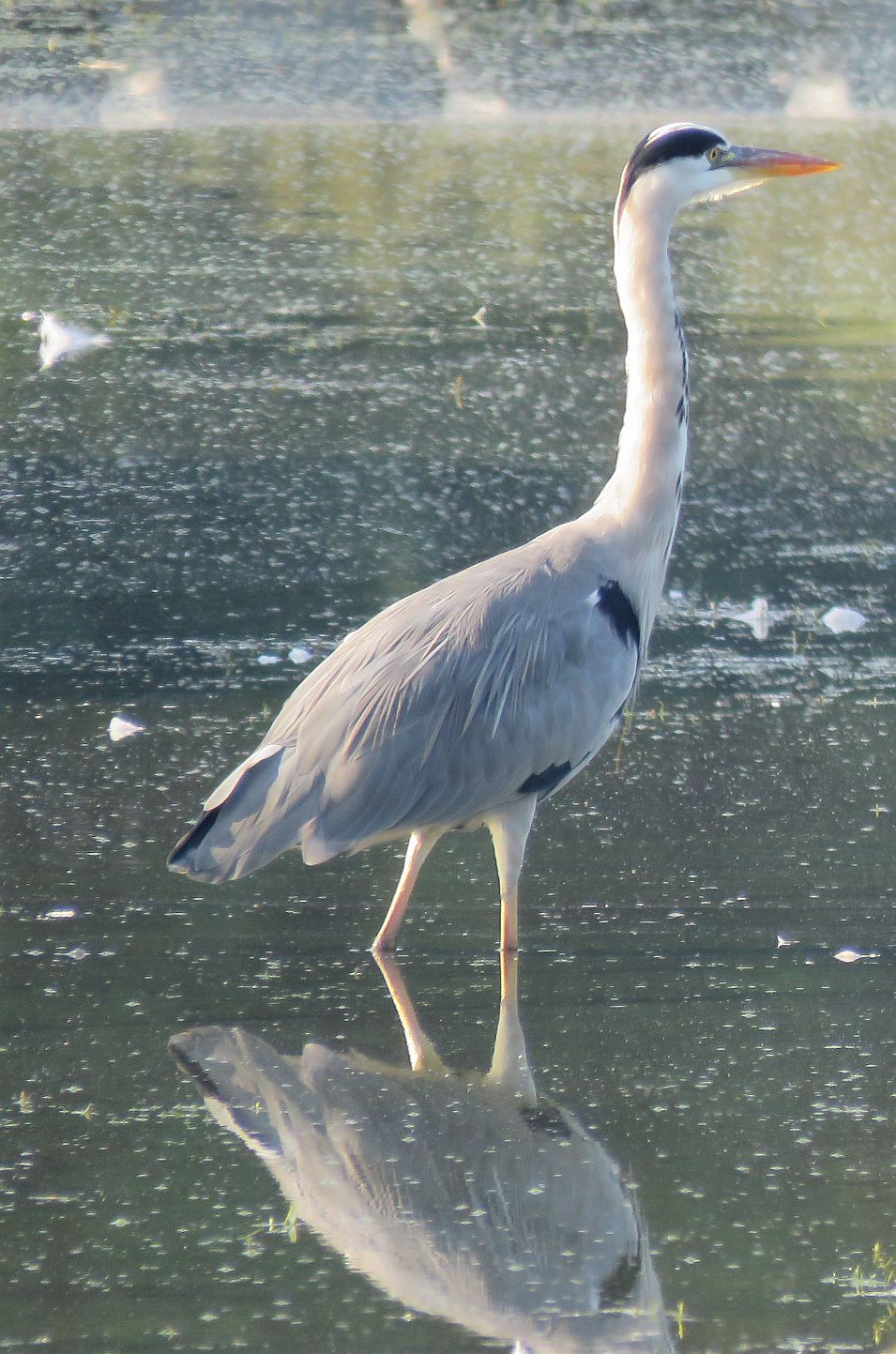 I was wandering in the car park field and by the Dinton Activity Centre in Area 10 this morning . One half of the car park field and its hedges were bathed in sunlight. Working their way along the hedgeline were Long tailed Tit , male and female Blackcap , several Chiffchaff ,a male Whitethroat and seen briefly a Lesser Whitethroat . Flying over were the resident Ring necked Parakeet also 15Egyptian Geese and a calling Green Woodpecker .
I was wandering in the car park field and by the Dinton Activity Centre in Area 10 this morning . One half of the car park field and its hedges were bathed in sunlight. Working their way along the hedgeline were Long tailed Tit , male and female Blackcap , several Chiffchaff ,a male Whitethroat and seen briefly a Lesser Whitethroat . Flying over were the resident Ring necked Parakeet also 15Egyptian Geese and a calling Green Woodpecker . 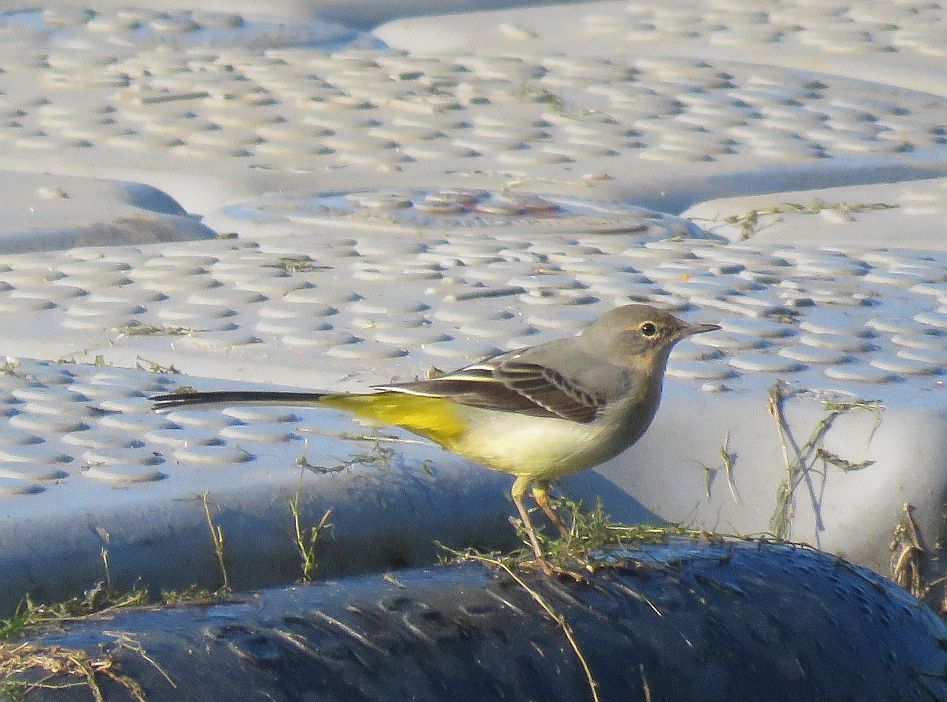 At the Activity Centre 4 (a family party) Grey Wagtail and a Grey Heron on the beach by the Sailing Club pontoon. At the Activity Centre 4 (a family party) Grey Wagtail and a Grey Heron on the beach by the Sailing Club pontoon.
01/09/17
In Area 4, Paul Bright Thomas had a Goldcrest in his garden and 15 House Martin heading South. At Old Forest Road Meadows Paul O'Neill was watching the skies and saw a Peregrine and 2 Buzzard . 2 adult and 1 juvenile. Also seen were Grey Heron , 2 Stock Dove , 6 Chiffchaff ,2 Blackcap , a solitary Swallow , 5 House Martin and a Grey Wagtail .
|
Insects
26/09/17
On the bridge over the Emm in Area 8 a Common Darter Sympetrum striolatum was sitting out in the afternoon sun.
24/09/17
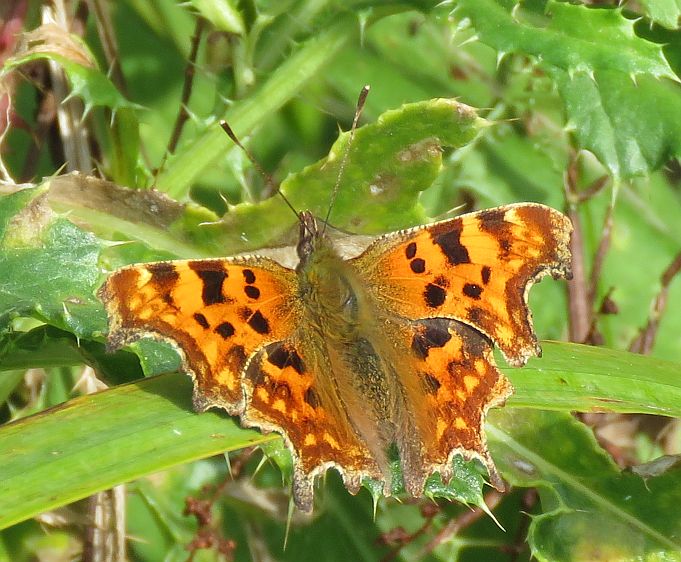 Around the pond in Area 5 a Comma Polygonia c-album butterfly was on the vegetation.
Around the pond in Area 5 a Comma Polygonia c-album butterfly was on the vegetation.
22/09/17
Butterflies are still on the wing seen in todays Area 10 sunshine were Large White Pieris brassicae and Red Admiral Vanessa atalanta .The Red Admiral is a migratory butterfly colonising the UK every year from the South. In autumn, the offspring of these spring arrivals migrate southwards.
20/09/17
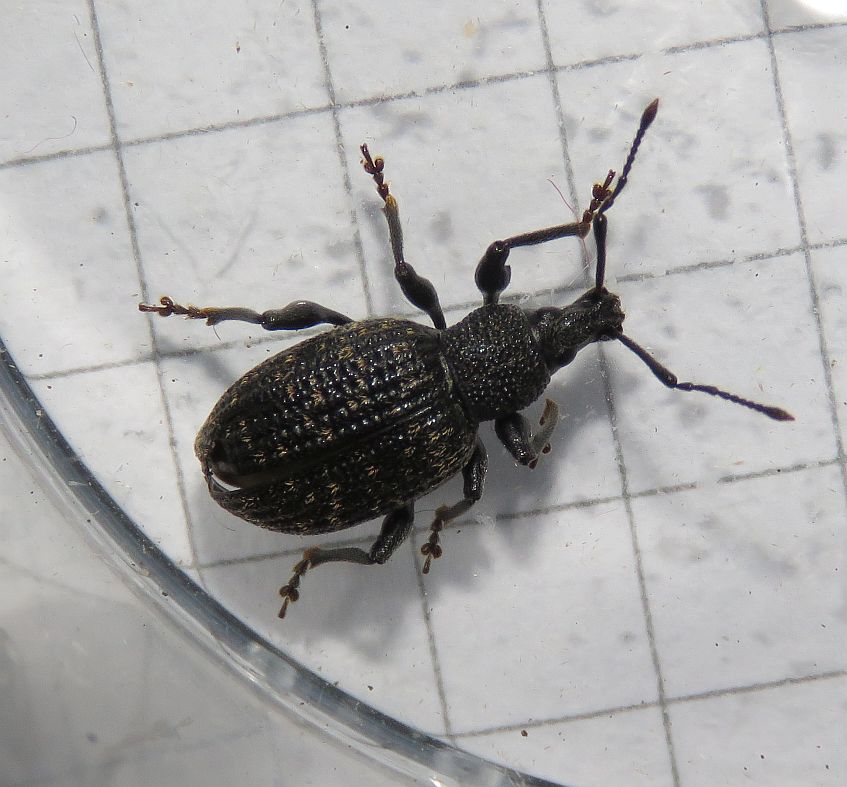 With my front door light on again last night in Area 5 a Vine Weevil Otiorhynchus sulcatus was on my front door.Not loved by keen gardeners as although Vine weevil are a native woodland species it loves to munch on young fibrous roots in the garden, whilst it is in its larvae stage. They were first discovered in the UK in 1998. The species is now reaching pest proportions and it has officially become the most common weevil.
The females can lay up to 1500 eggs with both adults and larvae able to survive our colder winters.
With my front door light on again last night in Area 5 a Vine Weevil Otiorhynchus sulcatus was on my front door.Not loved by keen gardeners as although Vine weevil are a native woodland species it loves to munch on young fibrous roots in the garden, whilst it is in its larvae stage. They were first discovered in the UK in 1998. The species is now reaching pest proportions and it has officially become the most common weevil.
The females can lay up to 1500 eggs with both adults and larvae able to survive our colder winters.
16/09/17
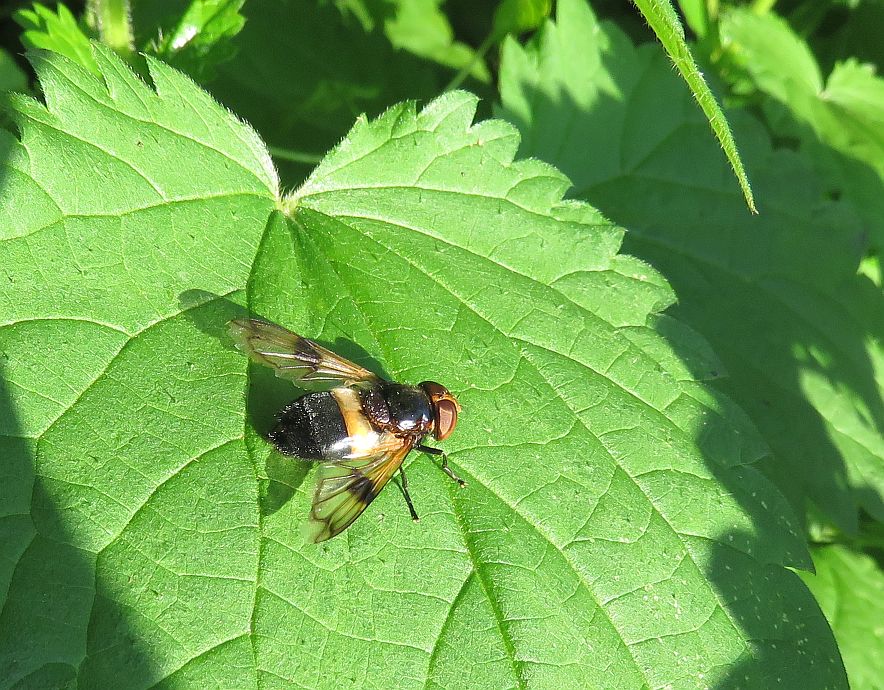 In Area 5 by the pond this morning, was a Pellucid Hoverfly Volucella pellucens it is also known as a Large Pied-hoverfly, due to the fact that's it one of the larger Hoverflies. Pellucid means transparent or translucent and in this instance refers to the ivory-white band across the abdomen, which if caught in the right light enables you to see through its middle. This and the dark spot on each wing makes this species quite easy to identify in the field.
In Area 5 by the pond this morning, was a Pellucid Hoverfly Volucella pellucens it is also known as a Large Pied-hoverfly, due to the fact that's it one of the larger Hoverflies. Pellucid means transparent or translucent and in this instance refers to the ivory-white band across the abdomen, which if caught in the right light enables you to see through its middle. This and the dark spot on each wing makes this species quite easy to identify in the field.
14/09/17
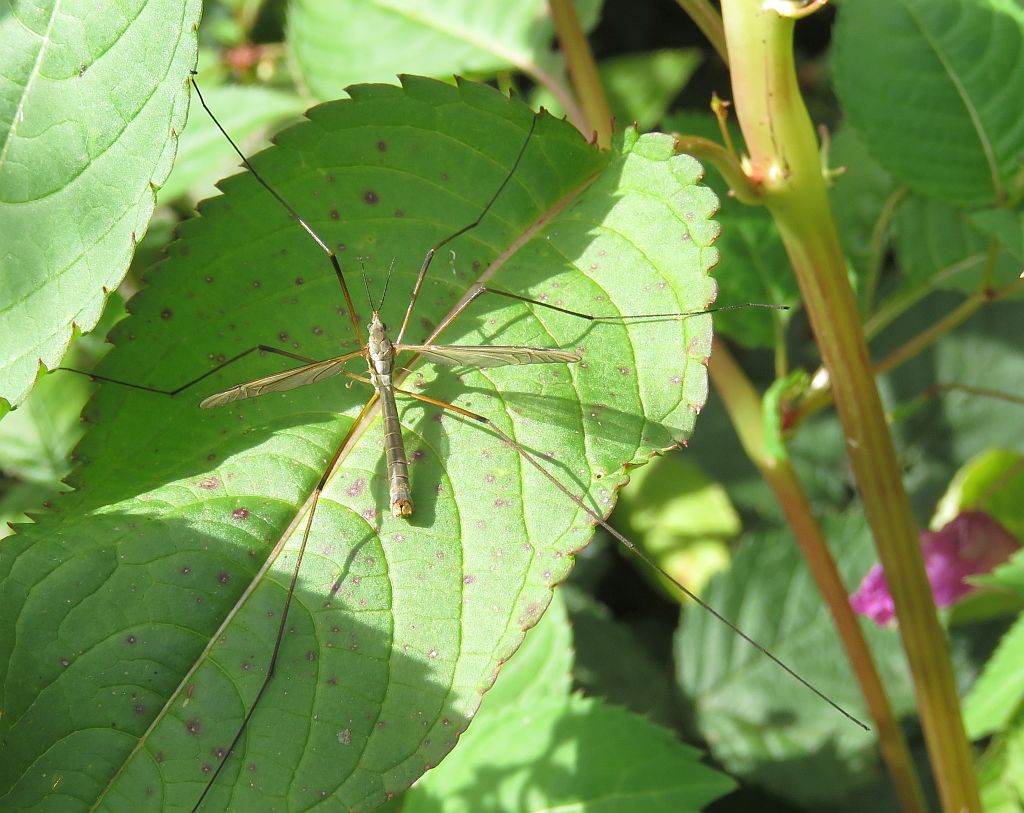 As befits the time of year, Craneflies have started to become more conspicious. This one is Tipula paludosa . The weather may be getting cooler but Common Blue Damselfly Enallagma cyathigerum are still very much on the wing. This one was in Area 10.
As befits the time of year, Craneflies have started to become more conspicious. This one is Tipula paludosa . The weather may be getting cooler but Common Blue Damselfly Enallagma cyathigerum are still very much on the wing. This one was in Area 10.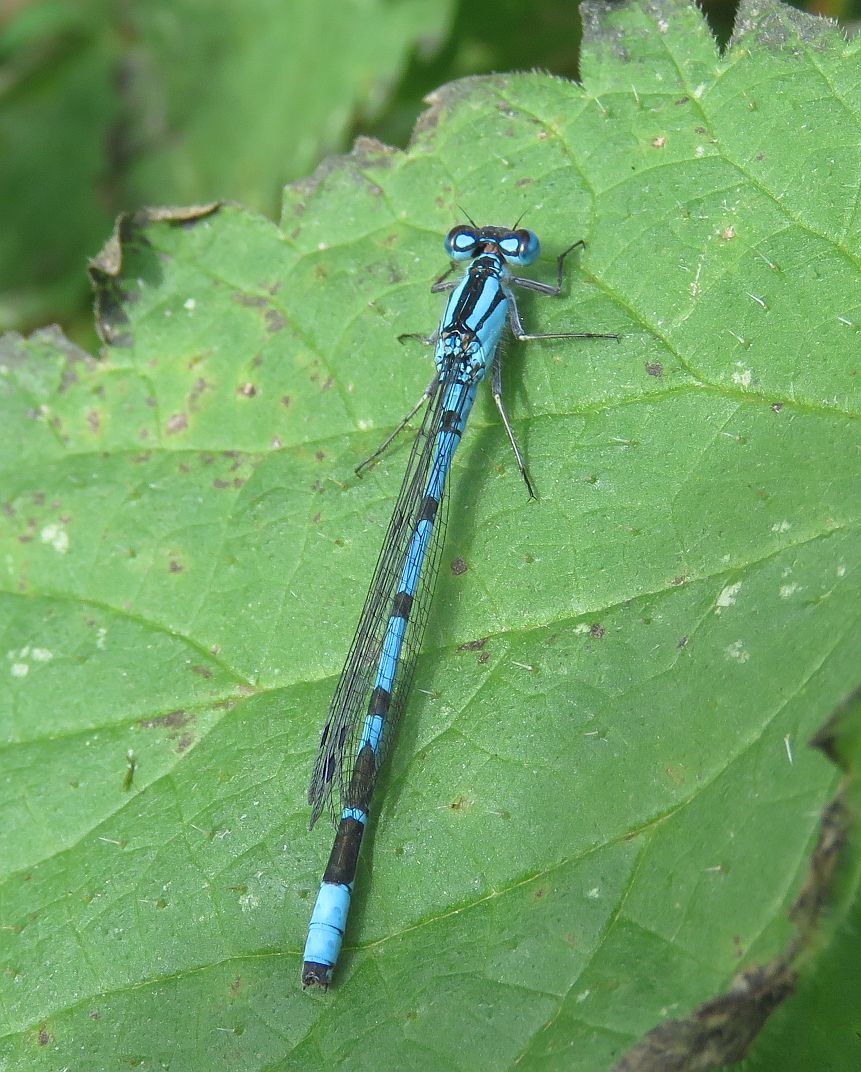 . In Area 5, the highlight of the day was a Ivy Bee Colletes hederae not suprisingly foraging for pollen on the Ivy flowers in Area 5.This bee was first recorded in the UK in 2001, . In Area 5, the highlight of the day was a Ivy Bee Colletes hederae not suprisingly foraging for pollen on the Ivy flowers in Area 5.This bee was first recorded in the UK in 2001,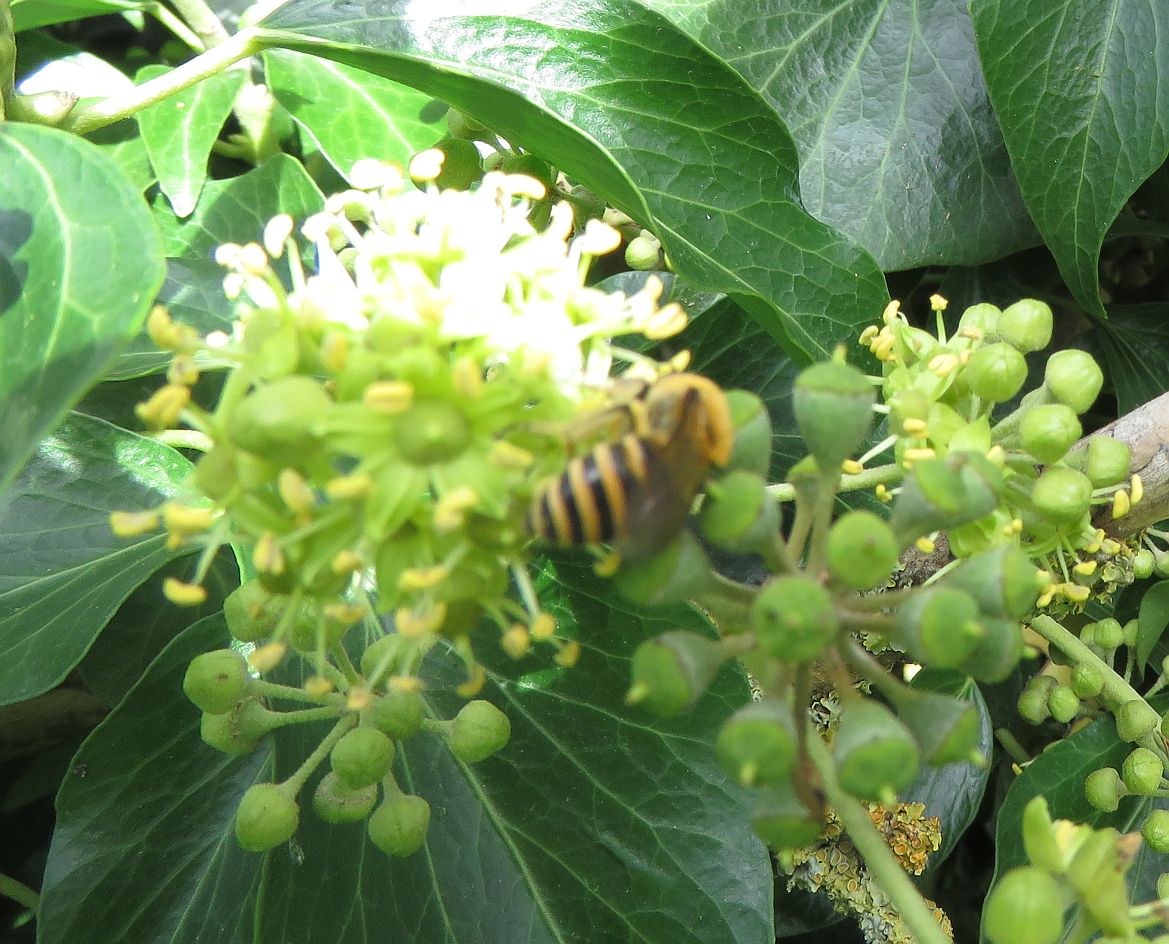 it has now been found in much of southern England and Wales and in the Channel Islands. The adult bees emerge late in the year coinciding with the start of the flowering season of their main food plant (Ivy). The males normally emerge a little bit earlier from the end of August followed by the females starting to emerge from early September. They are usually on the wing until early November. it has now been found in much of southern England and Wales and in the Channel Islands. The adult bees emerge late in the year coinciding with the start of the flowering season of their main food plant (Ivy). The males normally emerge a little bit earlier from the end of August followed by the females starting to emerge from early September. They are usually on the wing until early November.
11/09/17
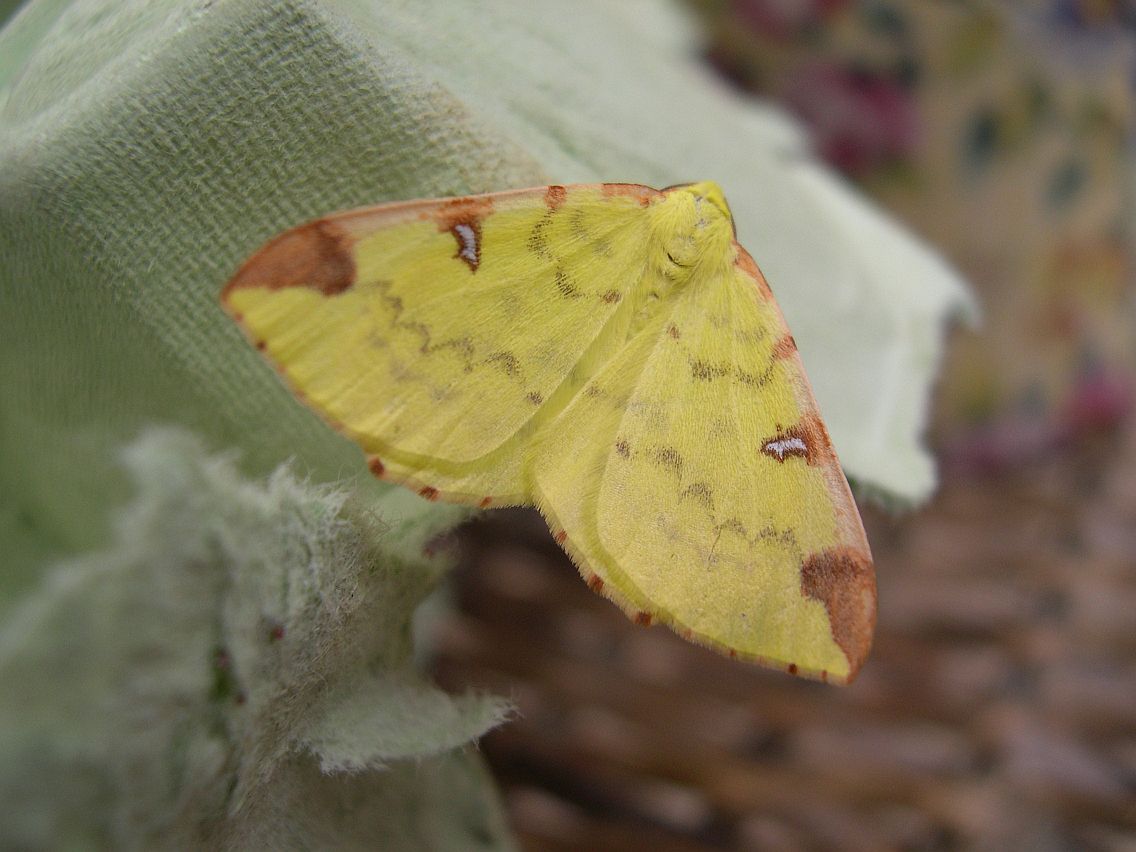 Tonights "Moth on the Door" was a Brimstone Moth Opisthograptis luteolata . This common moth flies from April to October and has at least 3 generations per year.
Tonights "Moth on the Door" was a Brimstone Moth Opisthograptis luteolata . This common moth flies from April to October and has at least 3 generations per year.
10/09/17
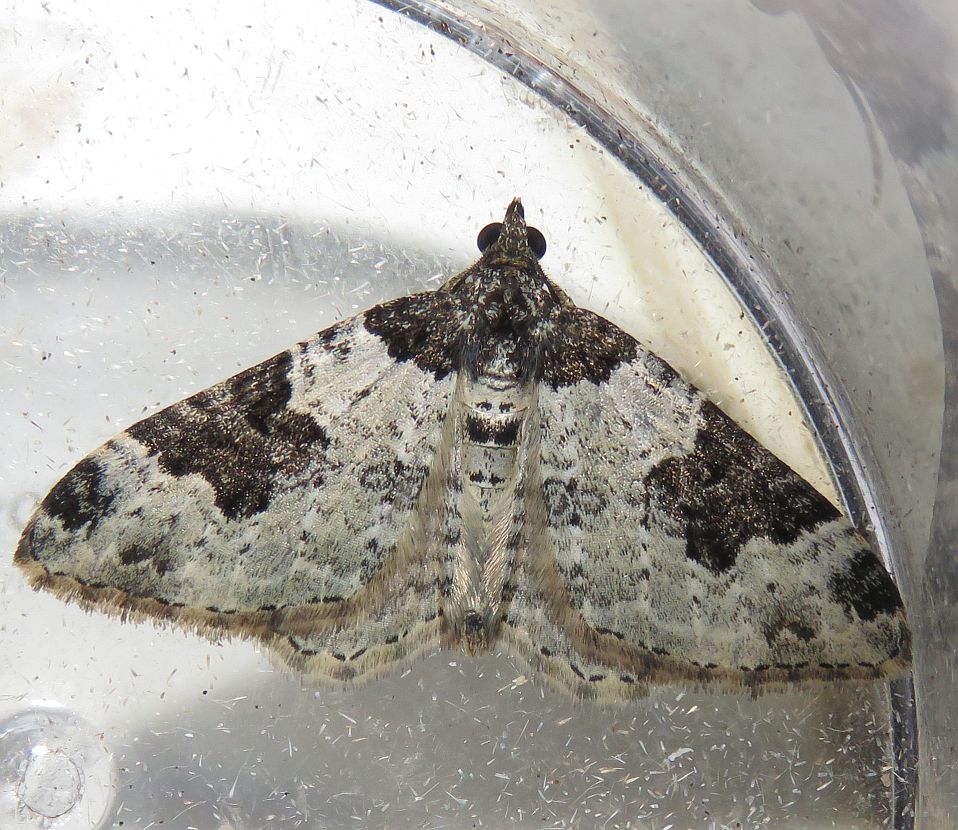 A quick check around my front door light before bedtime, produced a Garden Carpet Xanthorhoe fluctuata moth. This moth shows a preference for suburban habitats, but can be found almost anywhere.
A quick check around my front door light before bedtime, produced a Garden Carpet Xanthorhoe fluctuata moth. This moth shows a preference for suburban habitats, but can be found almost anywhere.
09/09/17
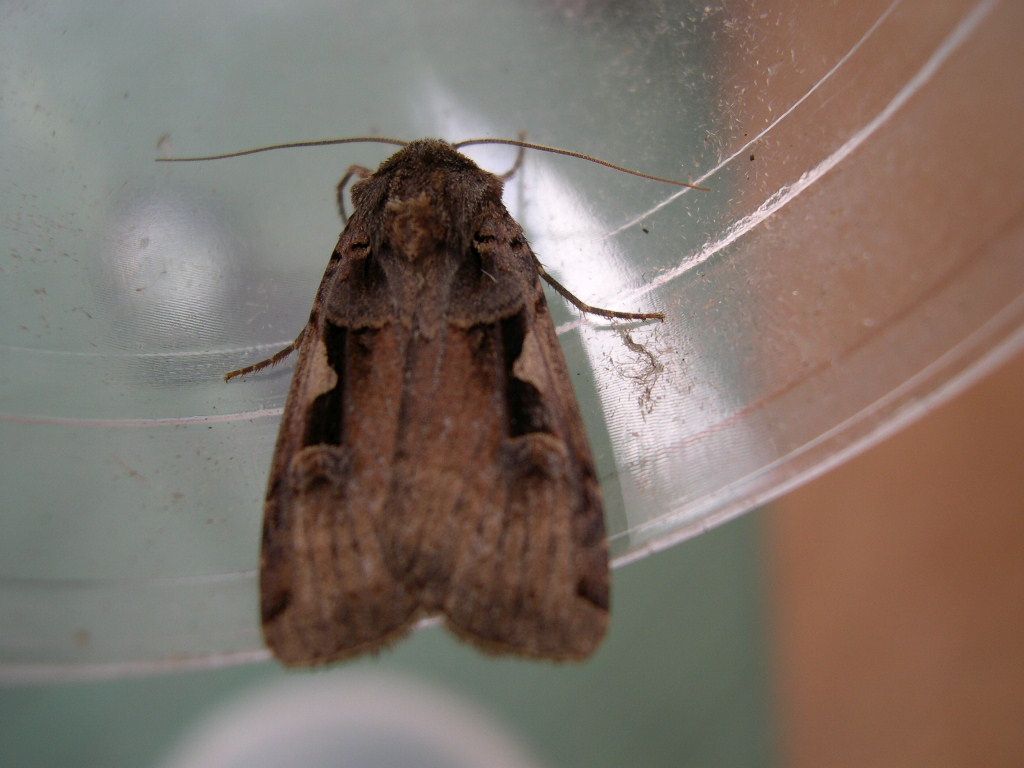 On the garden fence this morning was a Setaceous Hebrew Charecter Xestia c-nigrum moth. The wing markings apparently resemble a charecter from the Hewbrew Alphabet.
On the garden fence this morning was a Setaceous Hebrew Charecter Xestia c-nigrum moth. The wing markings apparently resemble a charecter from the Hewbrew Alphabet.1498.jpg) Along the river in Area 5 a male Helophilus pendules hoverfly, was on the Brambles. Along the river in Area 5 a male Helophilus pendules hoverfly, was on the Brambles.
07/09/17
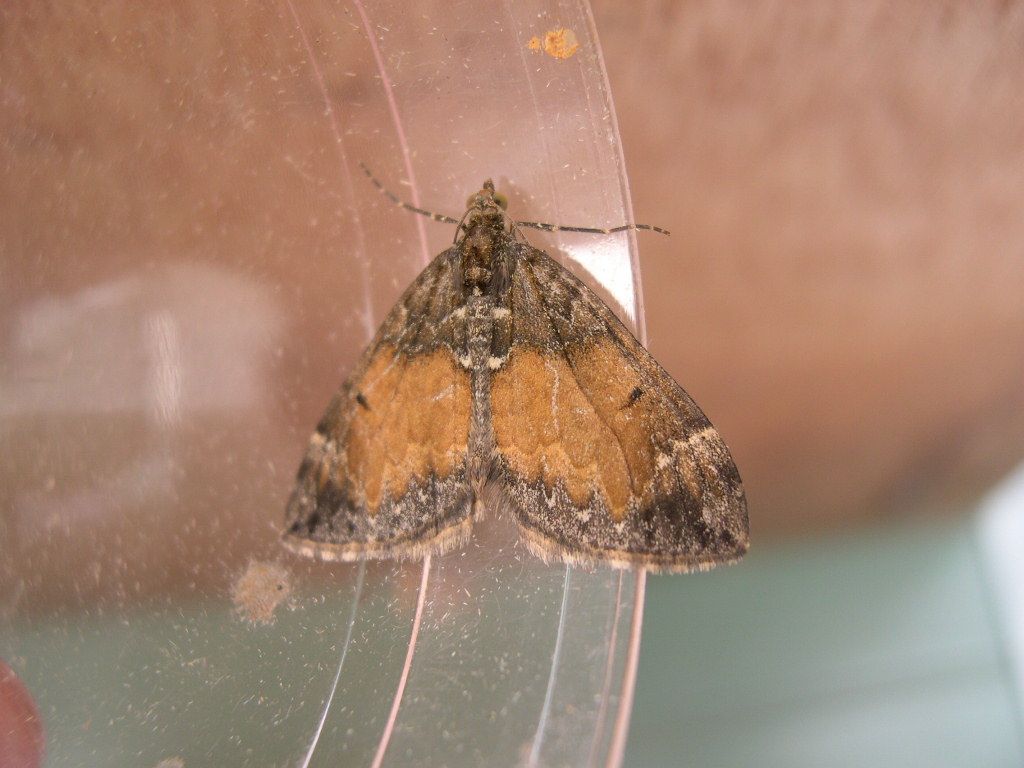 Despite the gloomy weather over the last few days, Butterflies are still on the wing. Once again the vast majority appear to be Large White Pieris brassicae these seem to have had a particulary succesfull breeding year, or maybe they are just more conspicuous. Also seen have been Meadow Brown Maniola jurtina . Attracted to my front door light was a Common Marbled Carpet Dysstroma truncata moth.
Despite the gloomy weather over the last few days, Butterflies are still on the wing. Once again the vast majority appear to be Large White Pieris brassicae these seem to have had a particulary succesfull breeding year, or maybe they are just more conspicuous. Also seen have been Meadow Brown Maniola jurtina . Attracted to my front door light was a Common Marbled Carpet Dysstroma truncata moth.
03/09/17
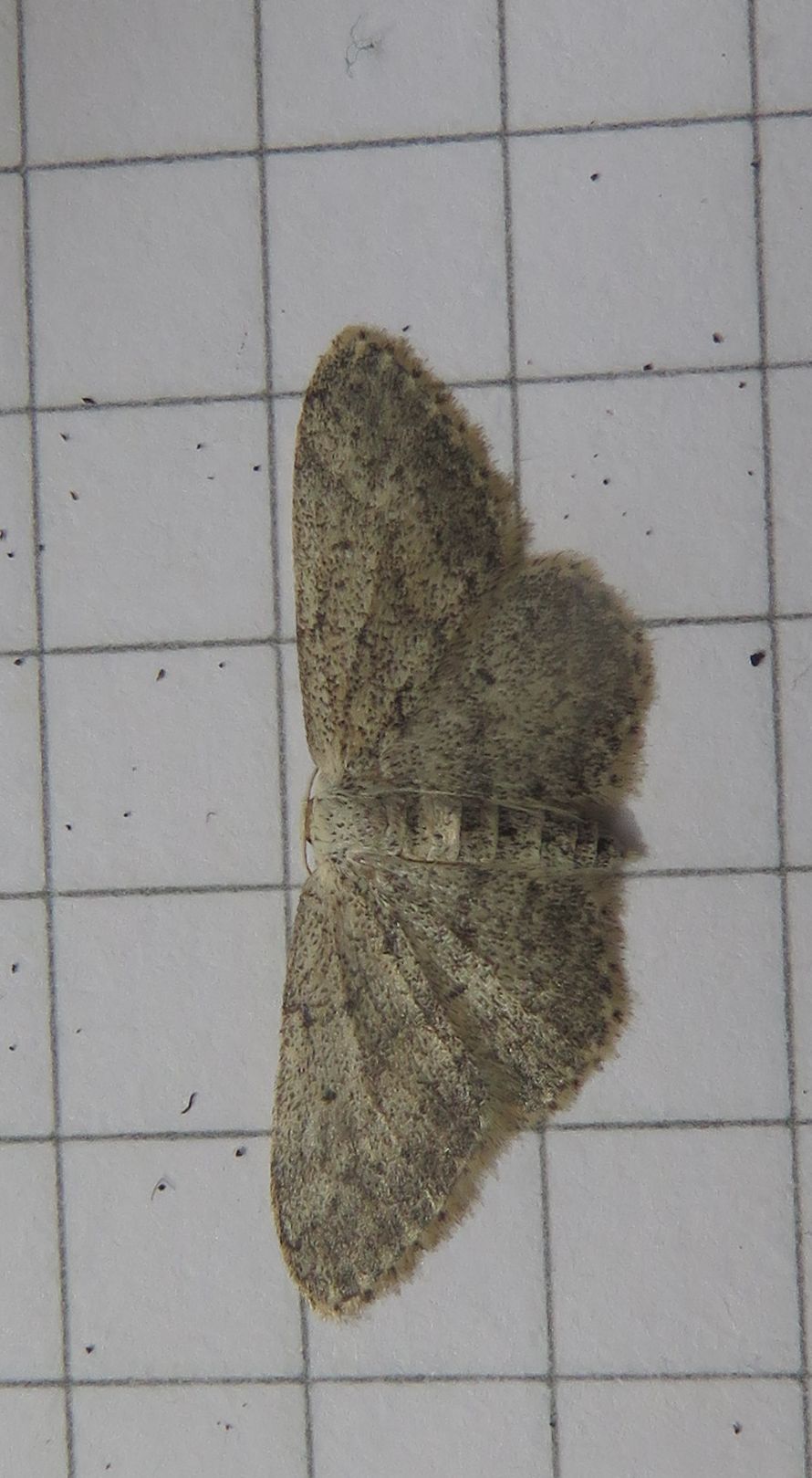 On the front door of my Area 5 house was a Small Dusty Wave Idea seriata moth this morning.
On the front door of my Area 5 house was a Small Dusty Wave Idea seriata moth this morning.
02/09/17
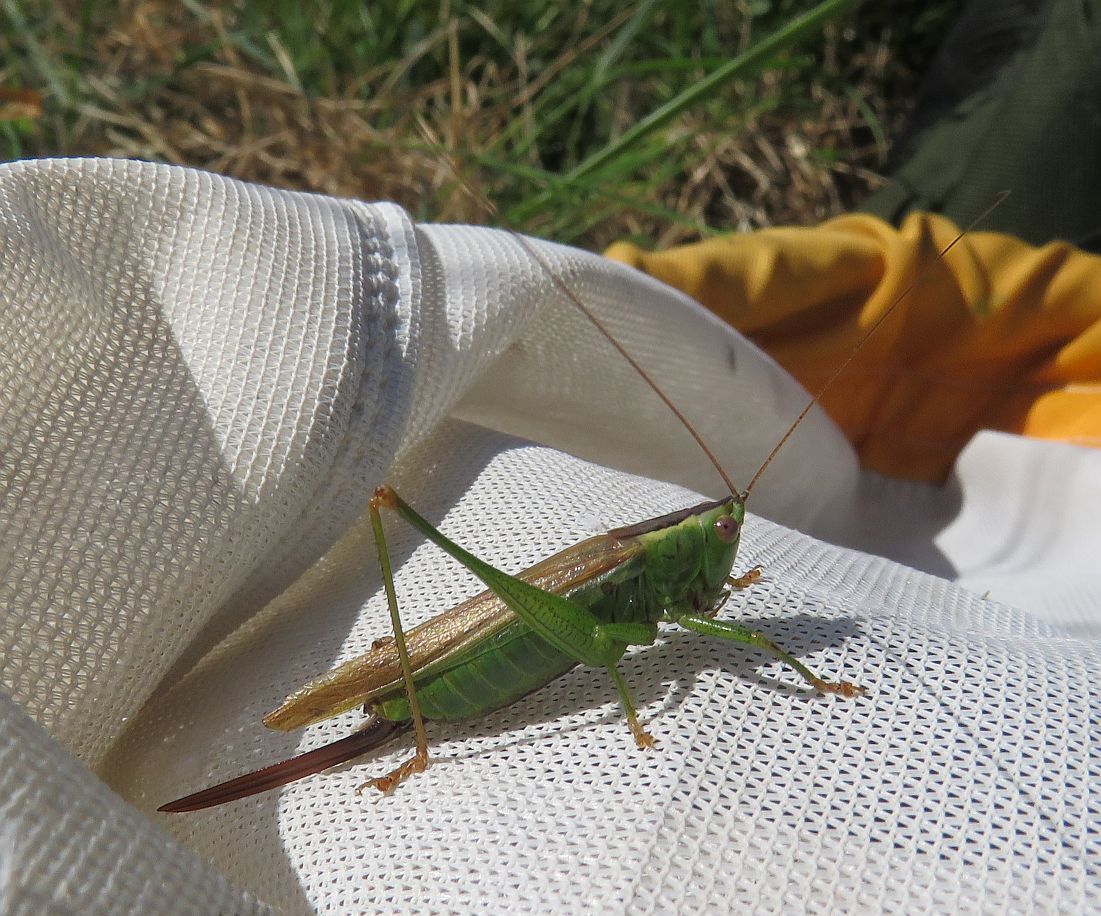 Back to Area 9 and Blackberry Gardens again at midday. Armed with my sweep net I went looking for bugs. In the rough grass was a Long winged Conehead Conocephalus discolor this is a female as you can tell by its ovipositor.This is a small Bush-cricket, named for the angled shape of its head.
Back to Area 9 and Blackberry Gardens again at midday. Armed with my sweep net I went looking for bugs. In the rough grass was a Long winged Conehead Conocephalus discolor this is a female as you can tell by its ovipositor.This is a small Bush-cricket, named for the angled shape of its head.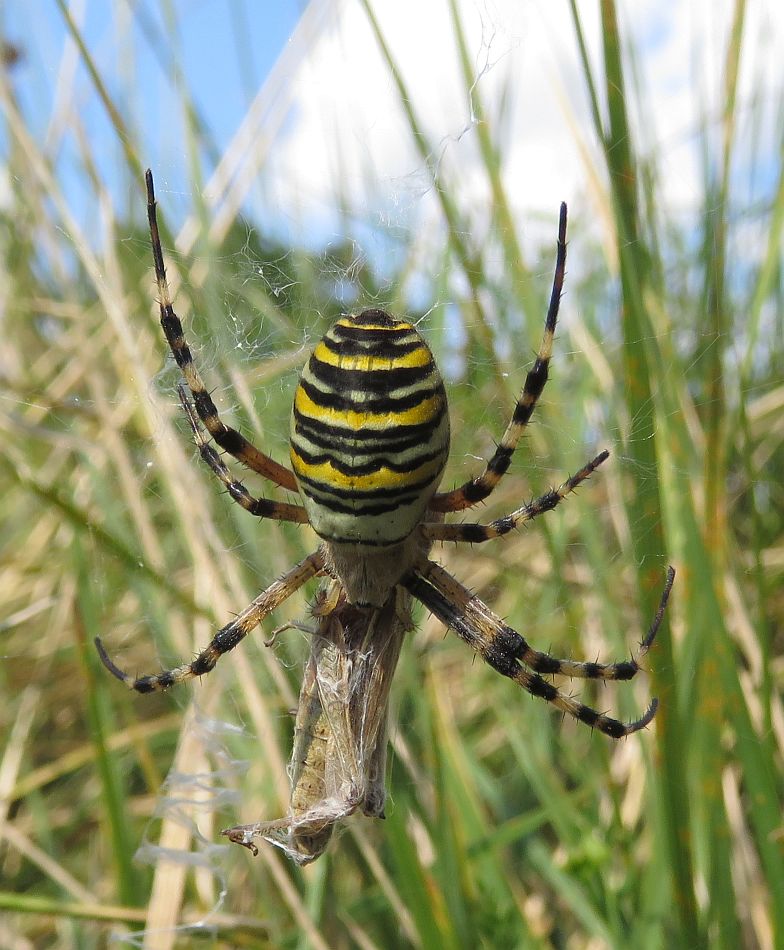 Today I found a real Spider, this is a Wasp Spider Argiope bruennichi
The Wasp Spider is a very large, colourful spider that is a recent (1920's) arrival in the UK from the continent and has slowly spread over the south of England. They build large orb webs in grassland and heathland, and attach their silk egg-sacs to the grasses. The web has a wide, white zig-zag strip running down the middle, known as a 'stabilimentum', the function of which is unclear. Mating is a dangerous game for males; they wait at the edge of the web until the female has moulted into a mature form, then take advantage of her jaws being soft and rush in to mate. However, many males still get eaten during this time. This picture shows a female with a Grasshopper as prey. Today I found a real Spider, this is a Wasp Spider Argiope bruennichi
The Wasp Spider is a very large, colourful spider that is a recent (1920's) arrival in the UK from the continent and has slowly spread over the south of England. They build large orb webs in grassland and heathland, and attach their silk egg-sacs to the grasses. The web has a wide, white zig-zag strip running down the middle, known as a 'stabilimentum', the function of which is unclear. Mating is a dangerous game for males; they wait at the edge of the web until the female has moulted into a mature form, then take advantage of her jaws being soft and rush in to mate. However, many males still get eaten during this time. This picture shows a female with a Grasshopper as prey.
01/09/17
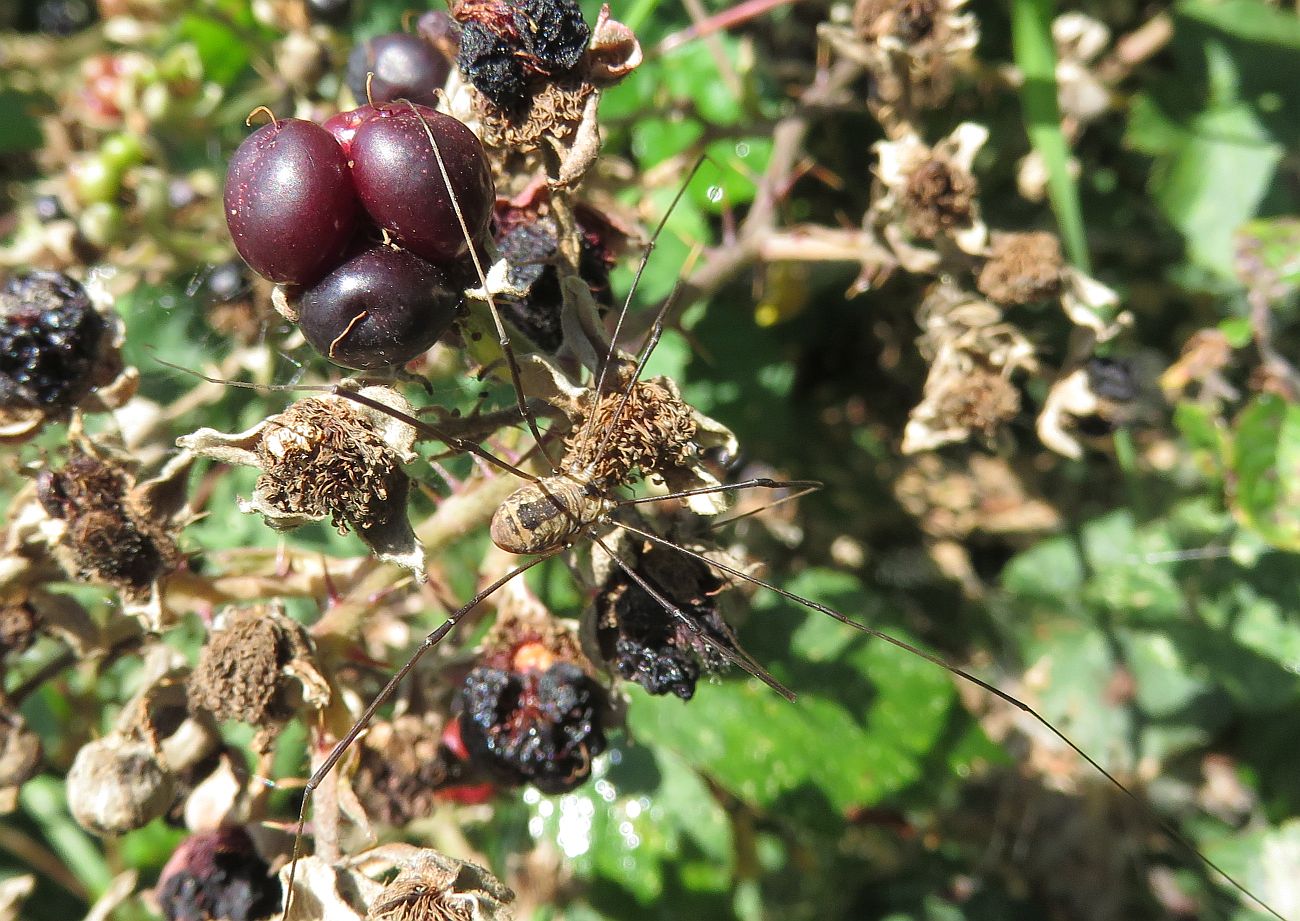 At Blackberry Gardens (Area 9) this lunch time the Harvestman Leiobunum rotundum was stalking prey on a Blackberry bush.
Although it looks like a long-legged spider, it isnít one. It is one of the Opilones, a group of arachnids closely related to spiders. Unlike the spiders, it has no silk glands so is not able to spin a web. It does not have fangs and does not produce venom.It catches its insect prey by using hooks on the ends of its legs. These arachnids defend themselves by secreting a foul-smelling fluid. If they are caught, they are able to shed a leg to escape.
At Blackberry Gardens (Area 9) this lunch time the Harvestman Leiobunum rotundum was stalking prey on a Blackberry bush.
Although it looks like a long-legged spider, it isnít one. It is one of the Opilones, a group of arachnids closely related to spiders. Unlike the spiders, it has no silk glands so is not able to spin a web. It does not have fangs and does not produce venom.It catches its insect prey by using hooks on the ends of its legs. These arachnids defend themselves by secreting a foul-smelling fluid. If they are caught, they are able to shed a leg to escape.
|
Other Wildlife
Plant/Trees
17/09/17
 Just by the bridge over the Emm Brook at the Area 10 car park field are several bushes of Guelder Rose Viburnum Opulus Guelder rose belongs to the same family as elder. In former times it was even called swamp-elder which shows its preference for boggy areas.The edges of the leaves are toothed. In the autumn, the leaves take on a beautiful wine-red colour.The fruits are a bright, shiny red and about the size of a pea.They are known as drupes and hang on the shrub until the beginning of winter.
Just by the bridge over the Emm Brook at the Area 10 car park field are several bushes of Guelder Rose Viburnum Opulus Guelder rose belongs to the same family as elder. In former times it was even called swamp-elder which shows its preference for boggy areas.The edges of the leaves are toothed. In the autumn, the leaves take on a beautiful wine-red colour.The fruits are a bright, shiny red and about the size of a pea.They are known as drupes and hang on the shrub until the beginning of winter.
14/09/17
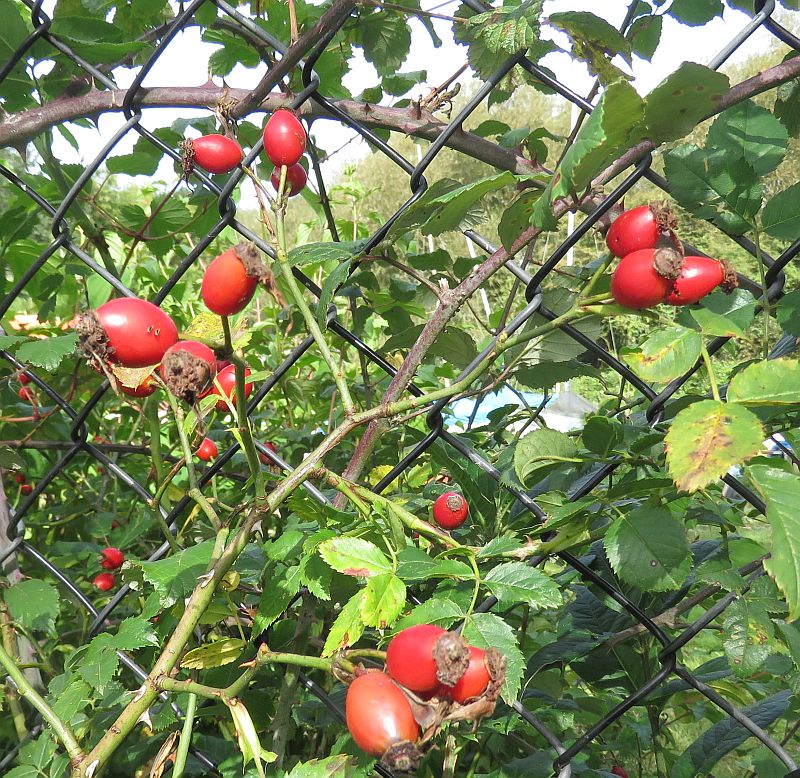 With the season of mists and mellow fruitfulness rapidly approaching, the first signs are showing. The Rose Hips of the Dog Rose Rosa canina are glowing bright red in the hedgerows.
With the season of mists and mellow fruitfulness rapidly approaching, the first signs are showing. The Rose Hips of the Dog Rose Rosa canina are glowing bright red in the hedgerows.
09/09/17
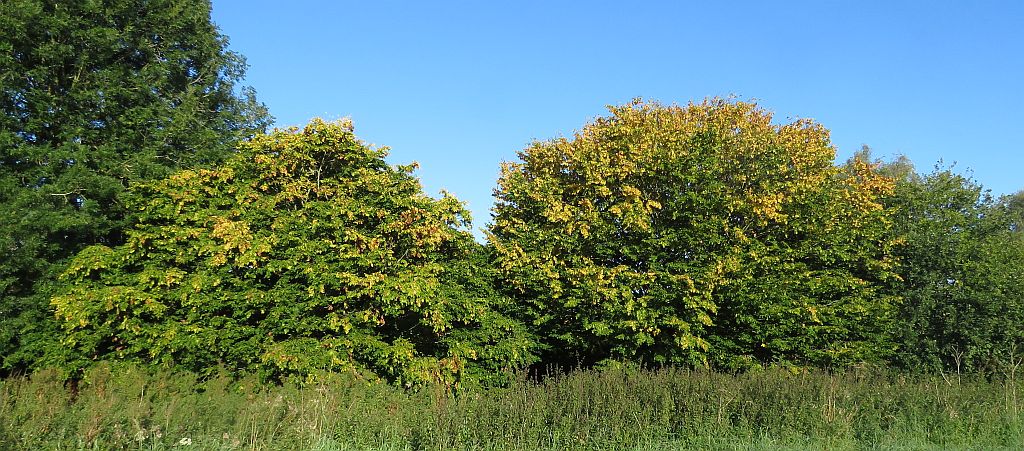 Along the Emm the first signs of Autumn are starting to show . To find out why the leaves change colour, click here
Autumn Leaves
Along the Emm the first signs of Autumn are starting to show . To find out why the leaves change colour, click here
Autumn Leaves
03/09/17
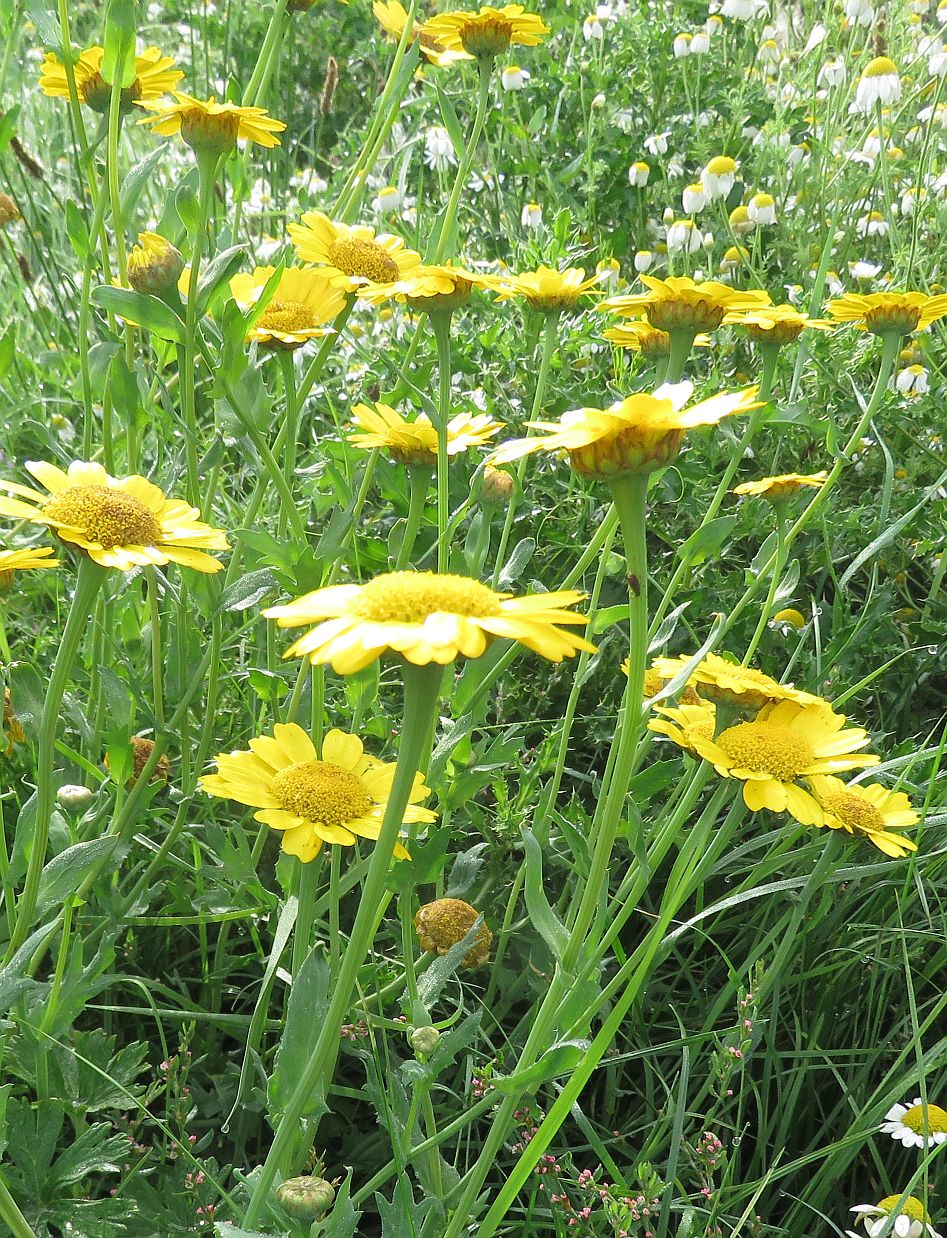 At Old Forest Road Meadows (Area 8) the seeded Wild Flower areas are currently showing Corn Marigold Chrysanthemum segetum and
At Old Forest Road Meadows (Area 8) the seeded Wild Flower areas are currently showing Corn Marigold Chrysanthemum segetum and 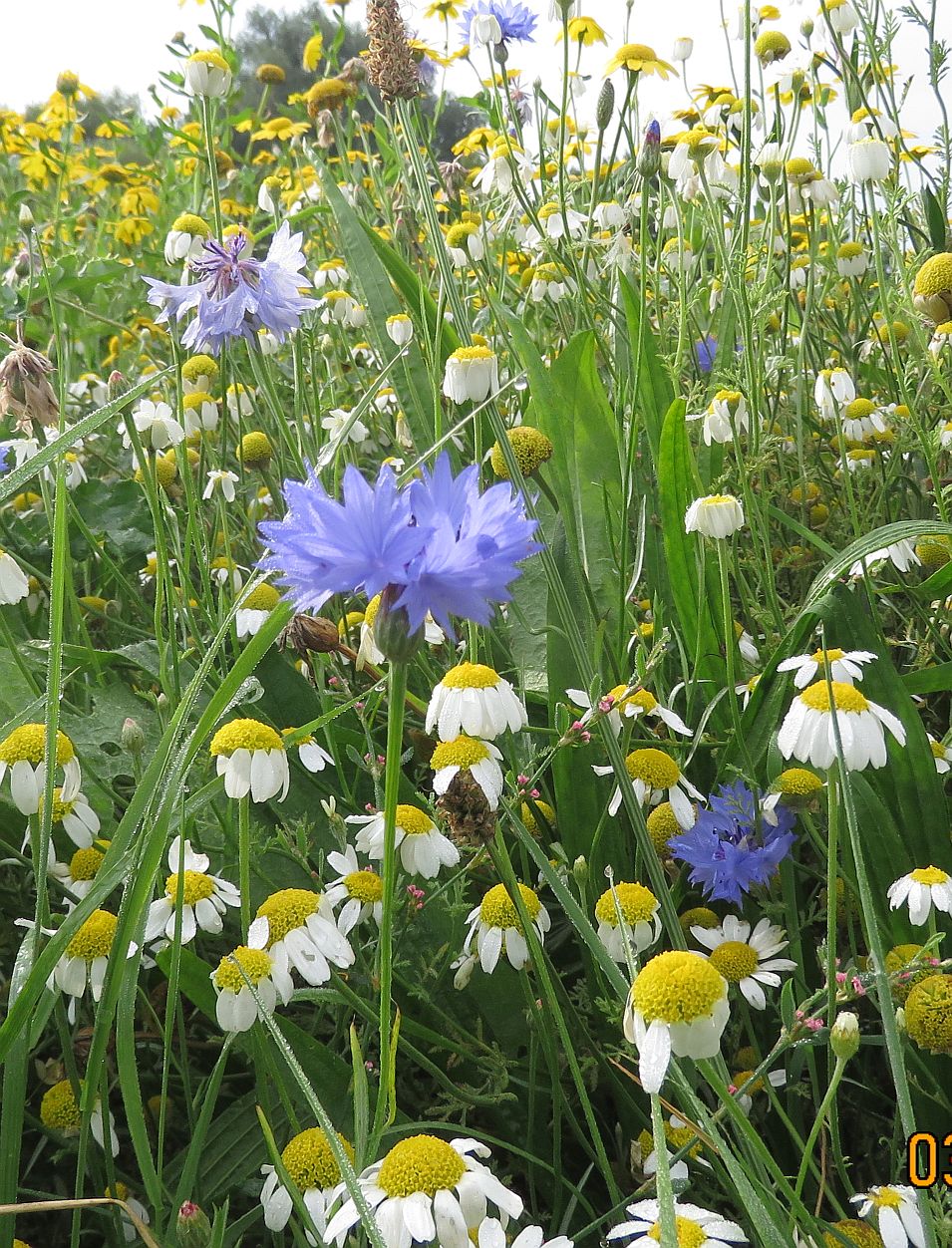 . Cornflower Centaurea cyanus. . Cornflower Centaurea cyanus.
01/09/17
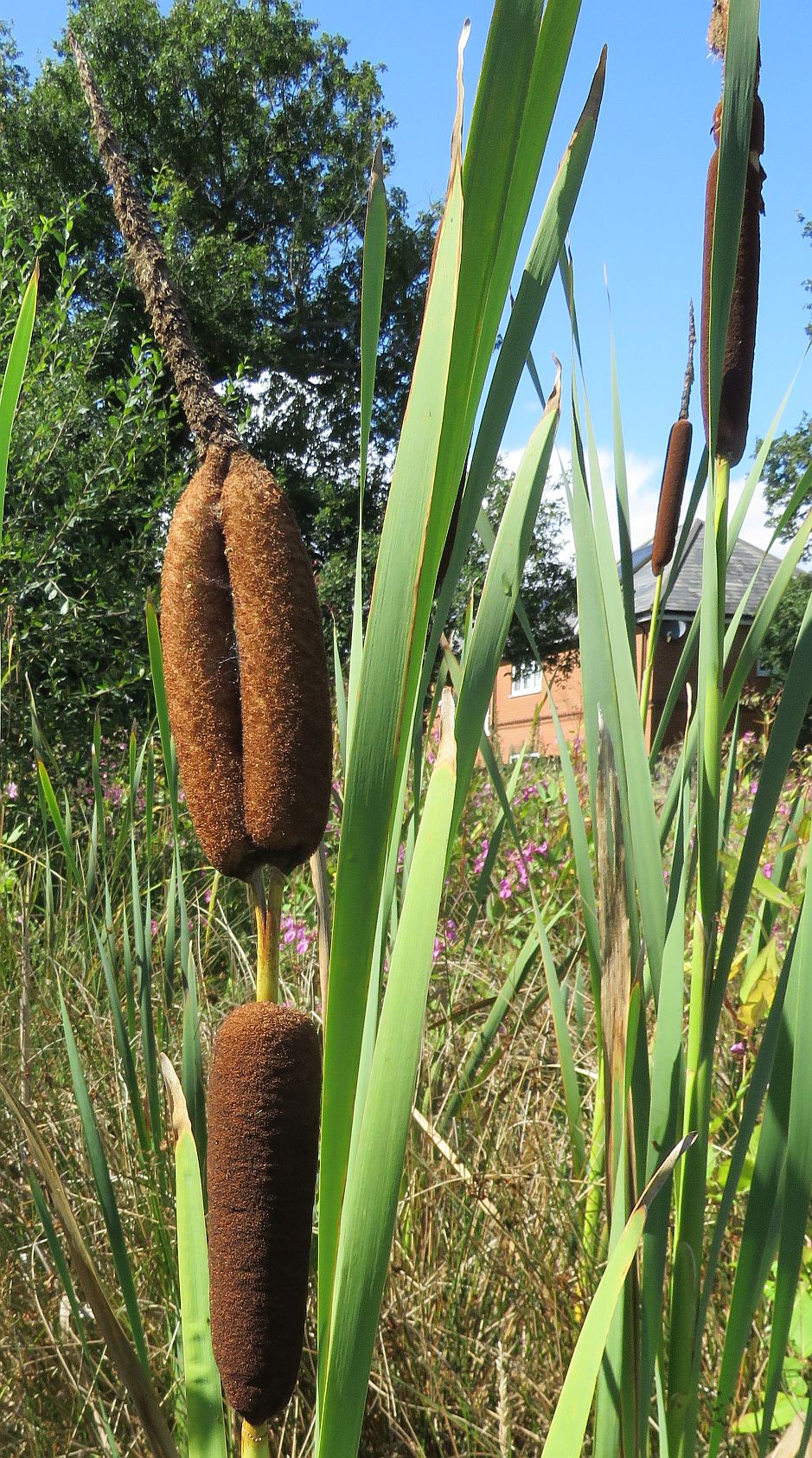 The area next to the Emm Brook at Blackberry Gardens (Area 9) is a bit of a marshy area. It is therefore no suprise that Greater Reedmace Typha latifoi probably more commonly known as Bullrush , are growing there.
The area next to the Emm Brook at Blackberry Gardens (Area 9) is a bit of a marshy area. It is therefore no suprise that Greater Reedmace Typha latifoi probably more commonly known as Bullrush , are growing there. 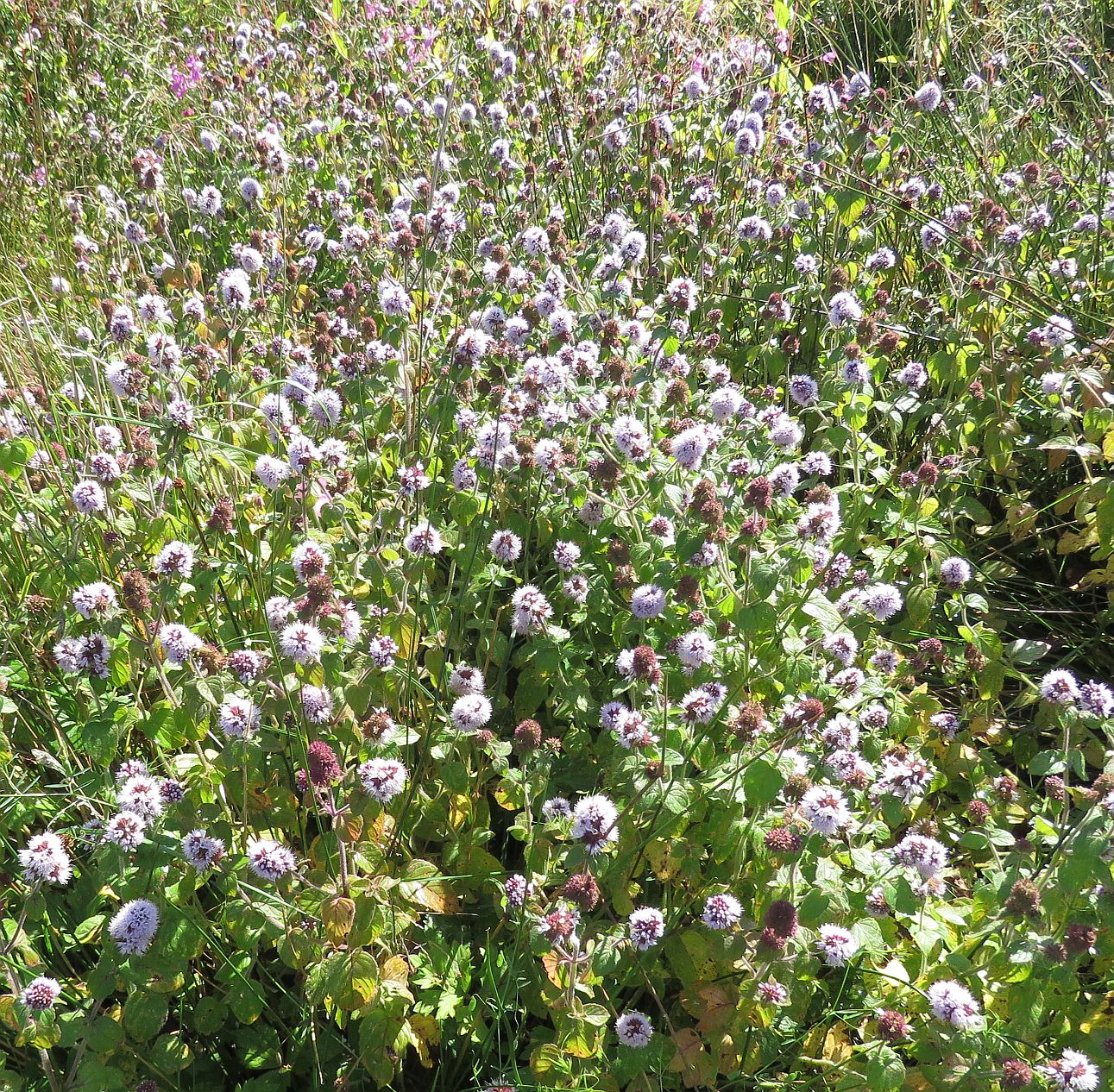 . Also consistent with the area is Water Mint Mentha aquatica. . Also consistent with the area is Water Mint Mentha aquatica.
Mammals
26/09/17
During some late season Balsam pulling at Area 8 and Old Forest Road Meadows a Roe Deer Capreolus capreolus was disturbed and ran away across the field.
17/09/17
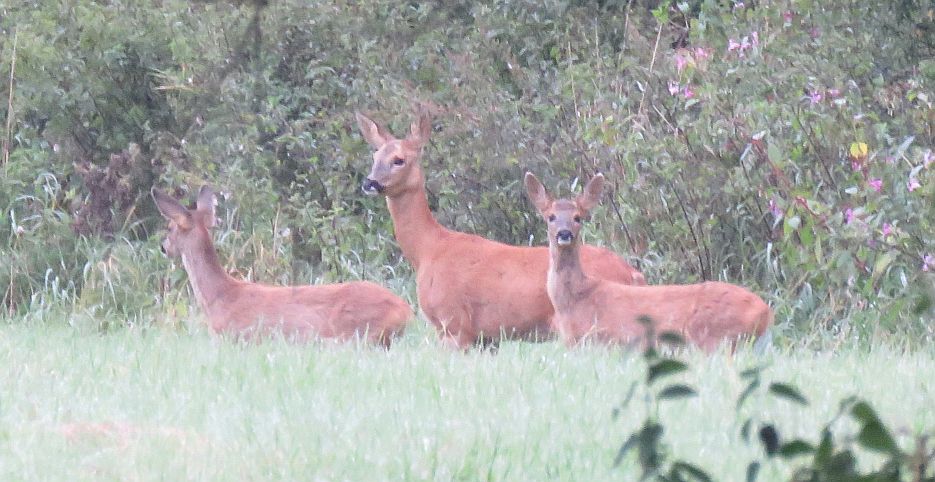 In Area 10 this morning, 3 Roe Deer Capreolus capreolus were in the field adjacent to the Emm at Lavells Lake.
In Area 10 this morning, 3 Roe Deer Capreolus capreolus were in the field adjacent to the Emm at Lavells Lake.
10/09/17
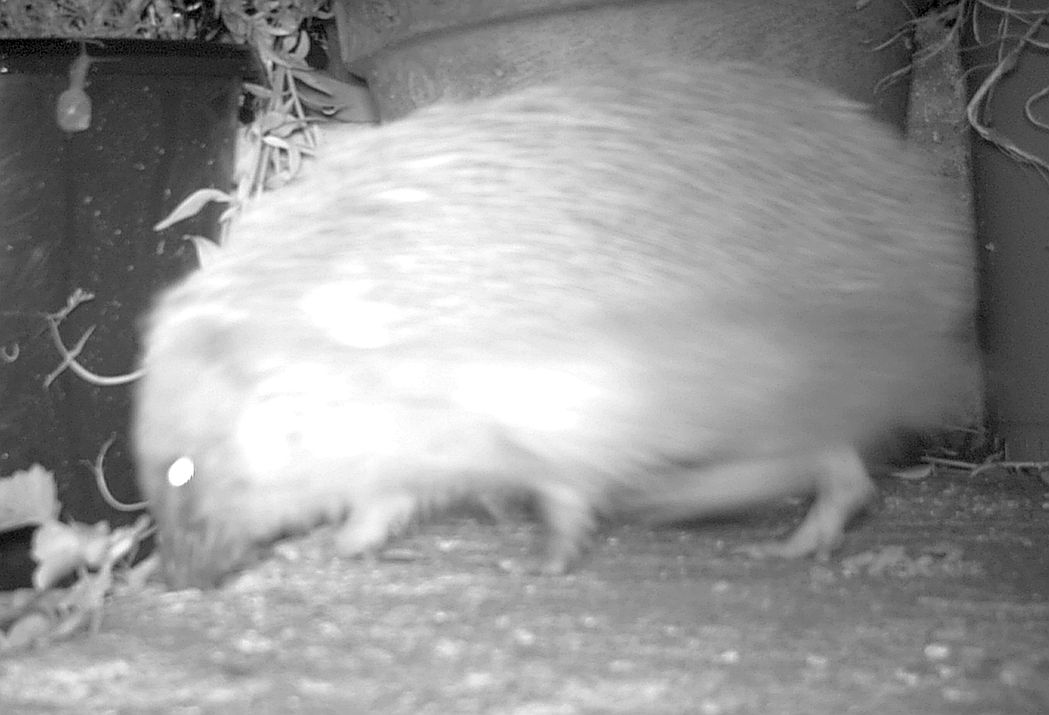 A Hedgehog Erinaceus europaeus was out and about in the early hours in my garden.
A Hedgehog Erinaceus europaeus was out and about in the early hours in my garden.
09/09/17
 It would appear thats its not only the birds that think its a good idea to strip my seed feeders. This Grey Squirrel Sciurus carolinensis has joined in the act.
It would appear thats its not only the birds that think its a good idea to strip my seed feeders. This Grey Squirrel Sciurus carolinensis has joined in the act.
03/09/17
 In Area 10 this morning the Rabbits Oryctolagus cuniculus seemed to have been watching too many Meerkat adverts.
In Area 10 this morning the Rabbits Oryctolagus cuniculus seemed to have been watching too many Meerkat adverts.
Molluscs
17/09/17
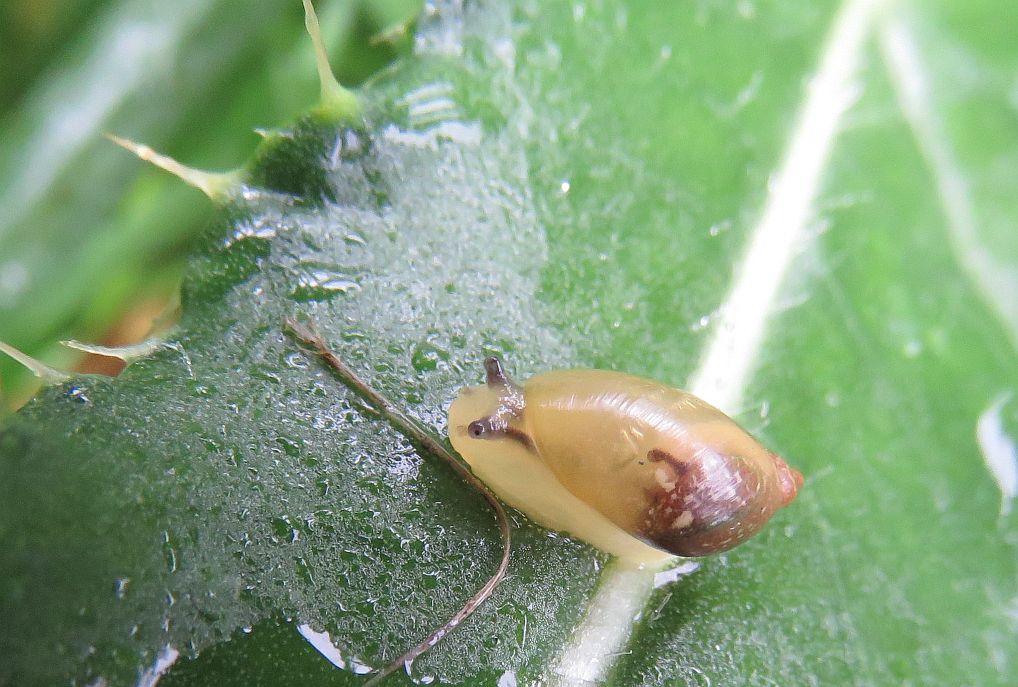 In Area 10 this morning an Amber Snail Succinea putris was in the vegetation.Amber snails have got a thin walled translucent shell, often amber coloured
In Area 10 this morning an Amber Snail Succinea putris was in the vegetation.Amber snails have got a thin walled translucent shell, often amber coloured
Fish
Fungi
24/09/17
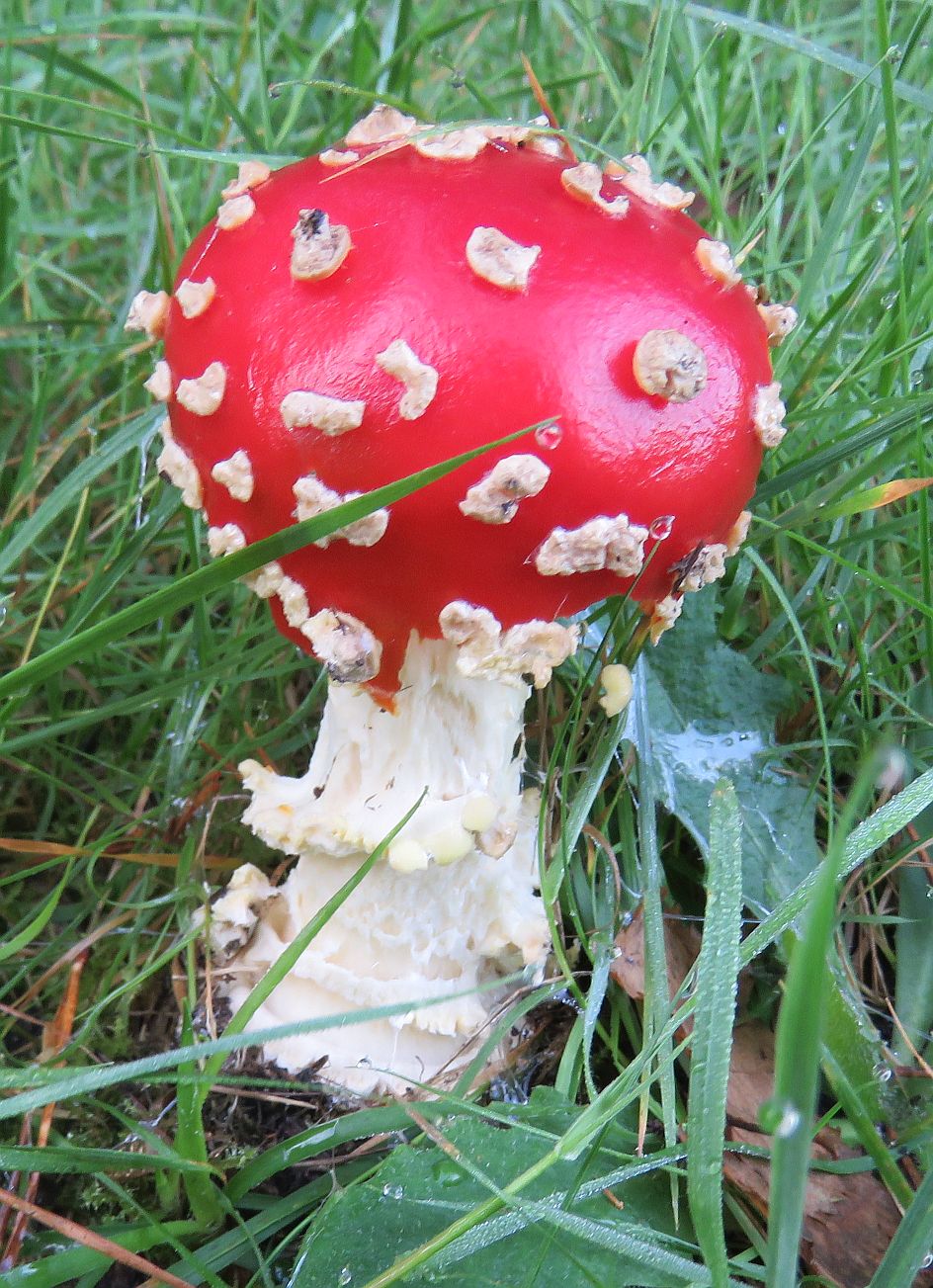 I visited Area 1 this morning, for a bit of a Fungi foray. First seen was the reliable Fly AgaricAmanita muscaria under the Birch trees.Another reliable fungus isYellow Stagshorn Calocera viscosa
I visited Area 1 this morning, for a bit of a Fungi foray. First seen was the reliable Fly AgaricAmanita muscaria under the Birch trees.Another reliable fungus isYellow Stagshorn Calocera viscosa  it can be found always growing on dead and rotting coniferous stumps and logs, or appearing to grow from the soil, but this is due to underground rotting wood. it can be found always growing on dead and rotting coniferous stumps and logs, or appearing to grow from the soil, but this is due to underground rotting wood. If you trudge across heathland or through conifer woods in the late summer through to early winter you may well encounter Earthfan Thelephora terrestris fungus. It is apparently fairly common according to my reference book , but new for me. This is a bit of an unusual species though as it is actually a bracket type of fungus. If you trudge across heathland or through conifer woods in the late summer through to early winter you may well encounter Earthfan Thelephora terrestris fungus. It is apparently fairly common according to my reference book , but new for me. This is a bit of an unusual species though as it is actually a bracket type of fungus.
17/09/17
 I'm fairly sure that this can be classed as a fungus In Area 10 on the gate at the car park field is Pixie cup LichenCladonia pocillum so named as the fruits look like tiny cups.The little pixies have probably been joining some of the other late night revellers in the car park.I couldn't however find any empty bottles of "Morning Dew".
I'm fairly sure that this can be classed as a fungus In Area 10 on the gate at the car park field is Pixie cup LichenCladonia pocillum so named as the fruits look like tiny cups.The little pixies have probably been joining some of the other late night revellers in the car park.I couldn't however find any empty bottles of "Morning Dew".
|






















1498.jpg)




















